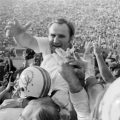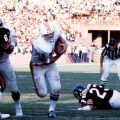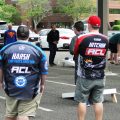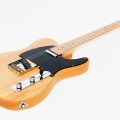JerseyMan

Eagles Tailgating: The Greatest Party in Greater Philadelphia
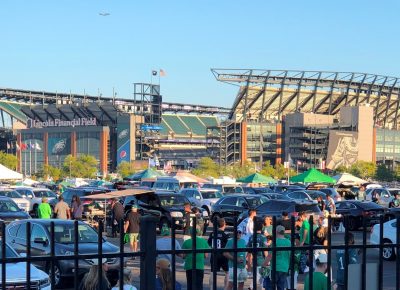
There is no gathering anywhere in the region like an Eagles tailgate. (Published for the Fall 2023 issue of PhillyMan…see the magazine article here.)

Most of the thousands clad in green at the party on Pattison probably don’t even realize it, but there is a truly special element to being in the parking lot on Eagles game day.
It’s that no matter your political persuasion, your religious denomination, your ancestral roots or your musical taste, you have something in common with the stranger next to you. In the parking lots surrounding Lincoln Financial Field on game day, everyone bleeds green and shows their commitment. On Game Day, the Birds are the only thing that matters to anyone.
Tailgating, at first glance, seems an alternative to paying the eternally brazen “atmosphere fee” for food and libations inside a sports venue. But when the party encompasses more than a square mile and looks like this, its purpose goes well beyond thrift. To call an Eagles tailgate a party, to even call it a celebration, is a rank understatement.
Throughout the lots at the home of the Eagles, including those meant for other teams who happen to play here, you can walk in any direction and see buses, campers, trucks and vans…the majority of them covered with artwork that would provoke a double take on the highway. It gives one pause to consider how much of a fan one must be to shell out the kind of coin needed to decorate a vehicle so magnificently.

After a long day of painting a bus, it’s time for a drink.
Everywhere in this mammoth block party, one hears loud music from a variety of styles and eras. Everywhere, you can smell coal, sausages, burgers, and yes, frequent whiffs of reefer. And anywhere you happen to be, you won’t often go five minutes without hearing an Eagles cheer…usually begun by one person, which easily gets at least a dozen more to join in.
If you’ve never been a part of tailgating at this level, you’ll be truly amazed at the dedication of a large number of participants. The seasoned pros arrive early…as much as six to eight hours before game time. (Do the math of how early you’d have to get out of bed, on a cold November Sunday morning, to tailgate for a 1:00 game.)
Veterans of Eagles tailgating even have their designated parking spots, that they head directly to when the gates open…for various reasons, such as being near a grate that can be used as a bathroom. True.
You can easily spot the amateurs…the late arrivals. They spend far too much time in an agonizingly slow quest…not only to find an open spot, but to work their way into it as carefully as possible to avoid gazebos, coolers, and equipment that other tailgaters have established hours before.
Hopefully they’ve learned their lesson from the experience…you need to take this party a heretofore unheard of other level of seriously.
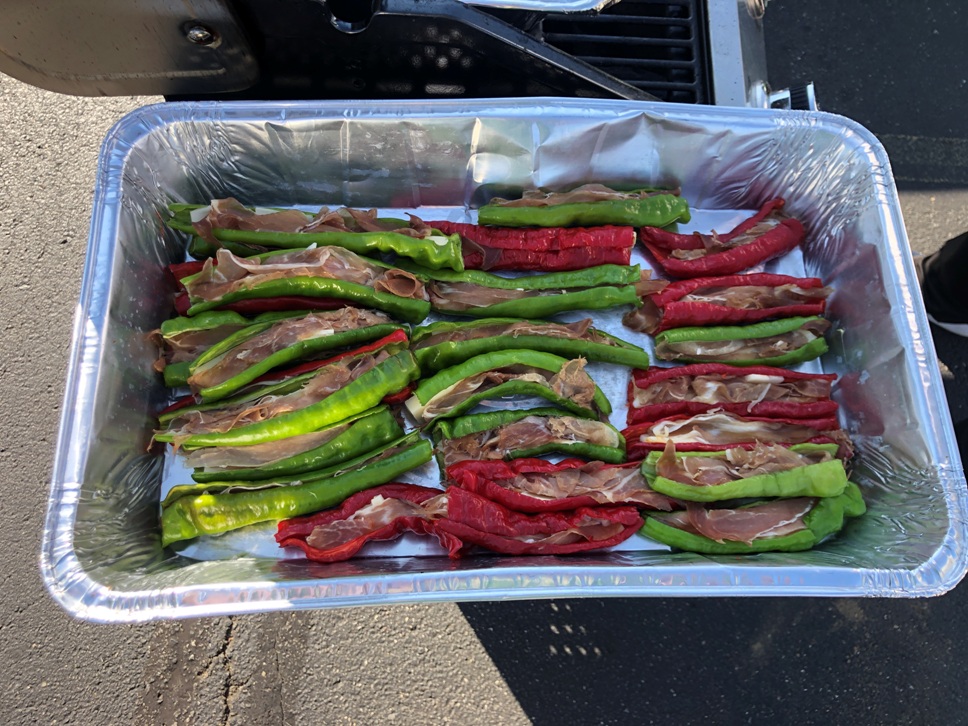
Dan Kukral’s stuffed long hots are reason enough to be part of the Danny Burke tailgate on game day.
Dan Kukral is the head chef of the Danny Burke tailgate, named for his brother-in-law who runs much of the party. He was given the chef’s role, he says, because “I come up with all the fun ideas for food.”
Kukral is a research scientist at a pharmaceutical company, which is remarkable given what you’re about to read about his contribution to game day.
He and Burke usually begin the party preparation about five to six days before game day (yes, you read that right). Once they’ve gathered food and supplies for a party that can be for as many as 200-300 people and brought it all to the Linc, he takes on the sizable cooking duties.
Needless to say, it’s a lot for one guy. Kukral simultaneously looks after the preparation of ribs, pulled pork, shrimp and sausage bayou, Buffalo chicken dip, and of course, dogs, burgers, wings, sausages with peppers and onions…even long hots with stuffed provolone and prosciutto. As anyone can easily see from the hefty, mouth-watering piles of grub, he’s more than up to the challenge.
It’s all a labor of love, he says. No kidding…a system as efficient as this doesn’t happen casually. The Danny Burke folks get contributions from participants, which covers the food and drink, but he doesn’t get paid for his more than considerable efforts.
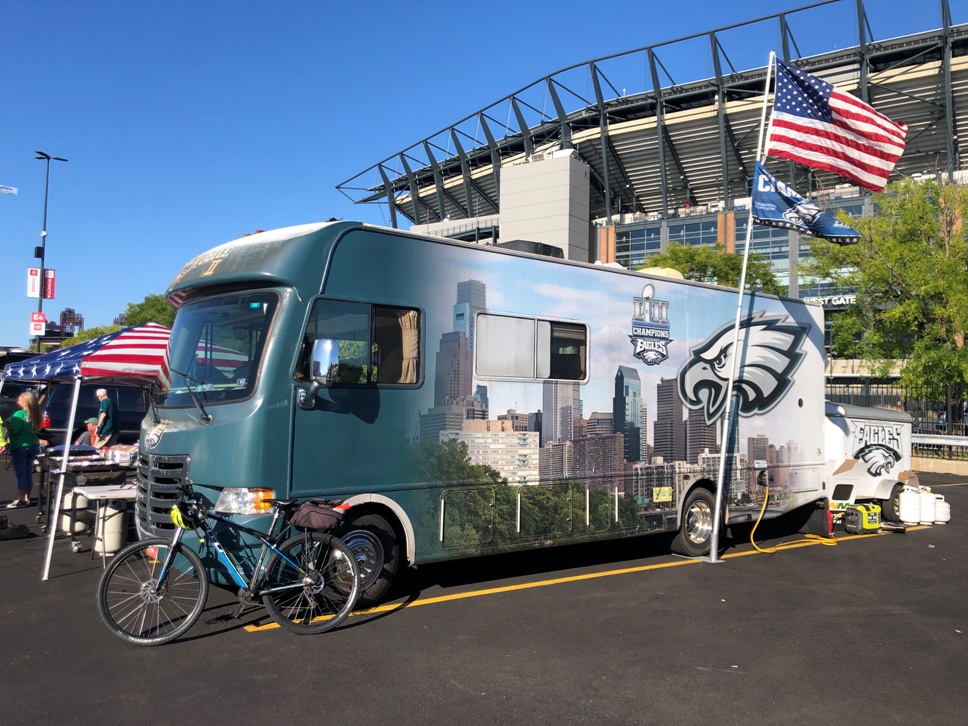
If you think this pain job is impressive, check out the back.
Kukral is just one of many for whom Eagles fandom is a passion worth the investment of time and money.
This observer also spoke with Ed Callahan, whose camper has occupied a spot in the Wells Fargo Center lot since the opening of Lincoln Financial Field. Ed tells an amusing story of why he and his crew acquired a camper.
“In 2004,” he recalls, “I went to a road trip game in Cleveland. There were four of us, and we parked in the lot next to a beat-up old RV. For a swap of a cheesesteak, the guy who owned the RV let us use the bathroom.”
An even trade, certainly. But bringing a bathroom to a tailgate, they realized, was a super idea, for obvious reasons.

“I’ll knock the loyalty to Kathie Lee right out of you!!”
Ed and his crew bought an old RV, fixed it up, and made it a staple of the parking lot. They eventually had to replace it following a wreck, so they’ve upgraded to a new one.
Callahan’s current camper is a thing of beauty to behold for a Philadelphia football fan, and it might be the most artfully decorated vehicle at the Eagles tailgate…which is undeniably saying something. The back of the RV is adorned with a large scale timeless image of Frank Gifford lying motionless on the field, following the epic Chuck Bednarik hit. On the side is a wide panorama skyline shot of our city, ranging from 30th Street Station to Billy Penn’s statue.
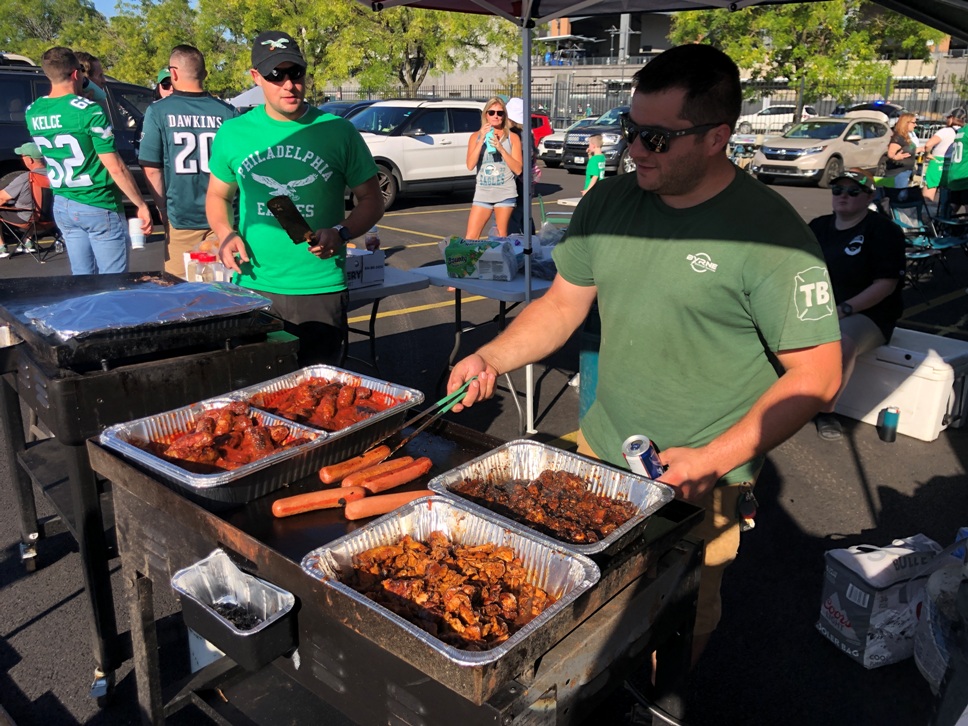
Anthony is the right man for the job.
The cook of Callahan’s crew is a gentleman named Anthony. Anthony is definitely keeping busy looking after sausages and other comestibles. He estimates that their party serves anywhere from 30-100 fans each home game.
Executing a successful tailgate, Anthony says, is a full-time job. “All week, getting food together, cleaning the RV, getting all the grills, utensils, tables, and all that. It’s a full day…breakfast, lunch and dinner in the parking lot.”
Ed says their breakfast specialty is an Irish American Philly Omelet… made with imported Kerrygold cheese from Ireland, Cooper brand American cheese, and Philadelphia cream cheese, all in a three egg concoction.
There might be a few NFL cities that are in Philadelphia’s universe when it comes to the magnitude of the pre-game party. But there is one thing that The City of Brotherly Love offers that is unique: cheesesteaks, scrapple and pork roll.
Buffalo can keep their wings, December weather, and four straight Bowl defeats.

These people need a lot of stuff.
To witness football fan dedication of this level brings to mind a whole world of entrepreneurial opportunities for local businesses. Incidentally, our friends at Duck Donuts realized this…on the day this article was written, the author received an email with a subject line that read: “Win The Tailgate With Donuts!” They get it.
Sure, for liquor stores, sandwich shops and food markets in the area, it’s obvious. Put it in your promotional materials that you offer everything Eagles fans need for Game Day…cases of beer, large bottles of liquor and mixers. Ready-made subs and pizzas, bulk packages of burgers, sausages, chips, dips, and rolls.
But that’s just scratching the surface. A party this size needs it all.

“Say, who painted your RV?”
An owner of an RV dealership can add a bar and lounge to the inside of a used camper to make a sale to a dedicated Eagles supporter. Vehicle wrapping and decorating outfits could market their wares to fanatics that buy multiple spots at considerable cost for their RV.
Needless to say, anyone selling Eagles gear could market to the block party…most all of whom represent their team faithfully with jerseys, caps, face paint or any kind of accessories featuring the Eagles logo and colors.
Outdoor stores could make a serious profit too. Grills, propane tanks, coolers, generators, portable toilets, anything associated with RV adventures might be applicable to a tailgating demographic. Space heaters and fuel would undoubtedly be in big demand in the colder months. Decorating anything with the Eagles colors and logo could make the sale to the typical Linc lot enthusiast.
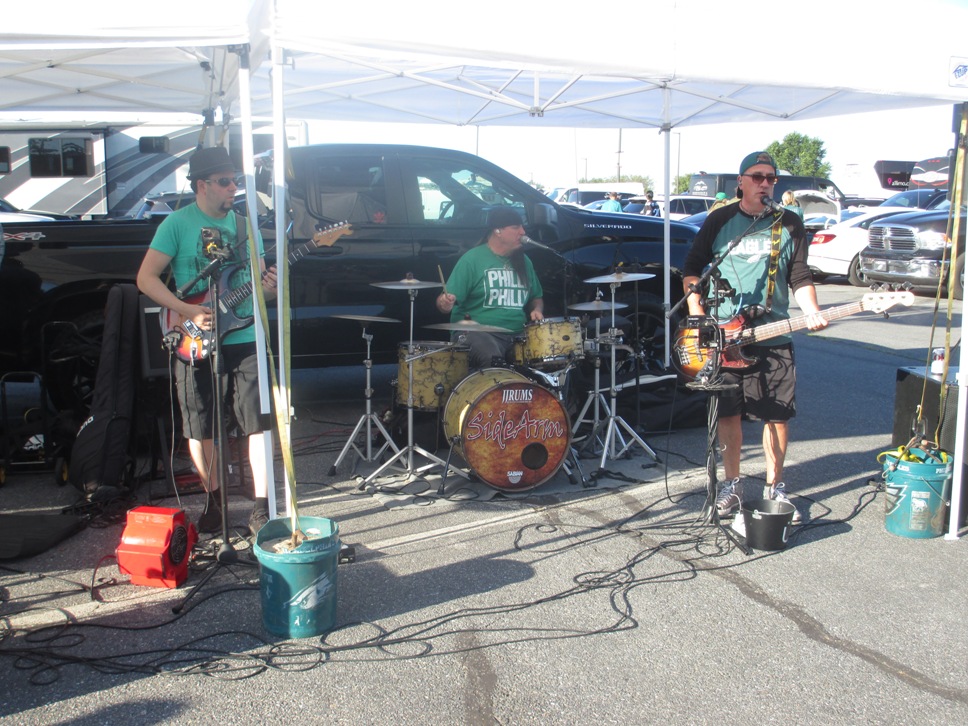
This band was playing Van Halen’s “Unchained”, and the guitar player handled himself quite well. It’s no place for amateurs.
It’s even an opportunity for catering services, private event coordinators, DJs, even live musicians, all of which you can easily find at an Eagles tailgate.
If nothing else, fly a plane towing a banner over it all for the thousands in the lot to see…which also happens frequently.
You get the idea, but even if you’re a realtor or a financial advisor, there’s no reason why you can’t build goodwill by renting a camper, hosting a game day party and inviting your customers, as one business owner (who asked for her name not to be shared) does.
No doubt, your Eagles fan patrons will speak well of you.
Because after all, you’re family.

As seen on the movie screen!
As Seen In The Movies: The Silver Linings Playbook Eagles Bus
If you’ve ever seen the movie Silver Linings Playbook…and if you’re a Philadelphian, you should…you likely remember the scene where the Eagles-decorated “Asian Invasion” bus shows up in the Linc’s parking lot on game day.
In the scene, protagonist Pat Solitano Jr., has just been released from a mental health facility for bipolar disorder. At the game, he notices that his therapist, Dr. Cliff Patel, has emerged from the bus.
He catches up with Patel…whose face is painted green and silver…and Patel dispels any concerns about their meeting outside of the facility: “Today, I’m your brother in green, not your therapist.” Soon, the two have a discussion with Pat’s friend about what the Eagles strategy for the game should be, punctuated with hilarious foul language.
After the movie was made, no one really knew what to do with the bus, and so a movie hand decided to sell it on Craigslist.
Bill Curley, a long, long time veteran of Eagles tailgates, went for it, and today the Asian Invasion bus is parked in the Wells Fargo lot for every Eagles home game.
“One of the people working on the movie ended up with the bus, and nobody wanted it,” Curley remembers. “The Inquirer wrote an article about how the bus was for sale prior to the Super Bowl. Once they won it, I called the guy on the phone and said, ‘hey is the bus for sale?’ and he said yes.”

The author of A Great Number of Things enjoys some time in the Asian Invasion bus.
Curley bought the bus for $9,000 in 2017. He estimates that he’s put a total of $30,000 into the investment. The bus is comfortably remodeled inside, with cushioned benches and Eagles decorated chairs, offering a spot to escape weather that can be trying in this part of the world any time of year.
“I come here early and park right here at the end, so people can take pictures. It attracts people from all over the country, I’ve had several people from Canada. A lot of ‘this is my first game, I’m from Utah, it was a birthday gift,’ they come and introduce themselves. It’s a neat thing.”
He still gets into the party, showing up early, saving spots for family and friends, and cooking sausage and peppers for whoever shows up. He was at the Linc at 11:30 AM for the Thursday evening home opener. “It starts early and it ends late,” he laughs. “My daughter’s coming today with her friends.
“This isn’t the most comfortable thing to drive in traffic, so I leave early.”
If you’d like to see the movie scene, you can search for “Silver Lining Playbook Eagles Tailgate Scene” on YouTube. And the next time you’re at an Eagles home game, check out the Asian Invasion bus…it’s well worth a look.
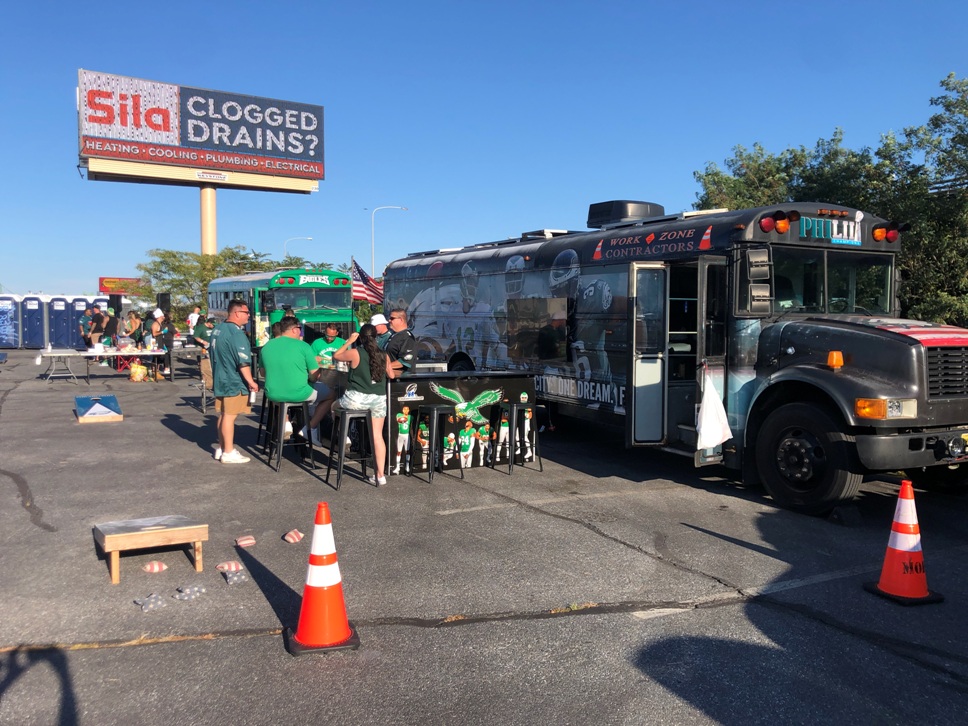
They mean it in the Jetro lot.
The Jetro Lot
While the Eagles tailgating scene is a thing to behold throughout all of the parking lots, some lots are at a different level of enthusiasm than others, and the parking lots at the Jetro Warehouse east of the Linc are undoubtedly the wildest.
To Philadelphians, the name “Jetro” is probably more known for what takes place in their parking lots than for what they do…they are a wholesale restaurant supplier, selling catering supplies and food preparation equipment to caterers and restaurant owners throughout the region.
But it’s likely that their most important…and maybe profitable…contribution to the city is their ample amount of parking spaces in the Sports Complex. The Jetro folks are, needless to say, aware of this, and they even have Facebook and Twitter pages dedicated expressly to their parking offerings for Philly sports events.
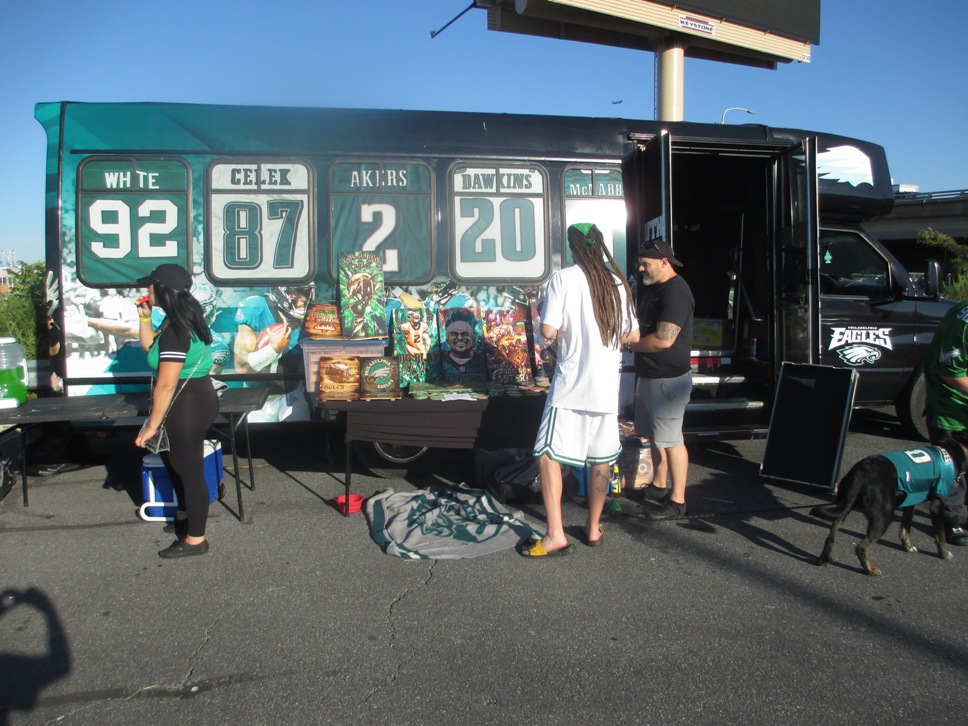
The art stylings of Jonathan Metz.
The most serious of Philly tailgaters seem to congregate at Jetro. In this observer’s visit, just a small sampling of things to see were a large number of beautifully decorated buses, a gentleman by the name of Jonathan Metz selling superbly Eagles-themed woodworks, coasters and other items, and a live band whose guitar player could mimic Eddie Van Halen’s licks quite well. That’s a ridiculously small sample, but magazines have space limits.
Jetro’s lot isn’t a place where you’d want to bring the kids or your church group. It’s loud and raucous, with music that often features lyrics full of f-bombs. There’s also a few flags that are openly critical of the current occupant of the White House, and not in a polite way.
But if you can handle that, and you truly want to show your Eagles fan dedication, the Jetro lot is likely the destination for you. It’s well worth a visit, if only just to see the level of fandom the local football team inspires.

Foodie Hall in Cherry Hill

The best assignments a writer could ask for are the ones that include free food…but especially when that food is from recipes concocted by gourmet chefs. JerseyMan sent me to cover the opening of FoodieHall in Cherry Hill…a great place for outstanding grub. Check out the article from the magazine here.
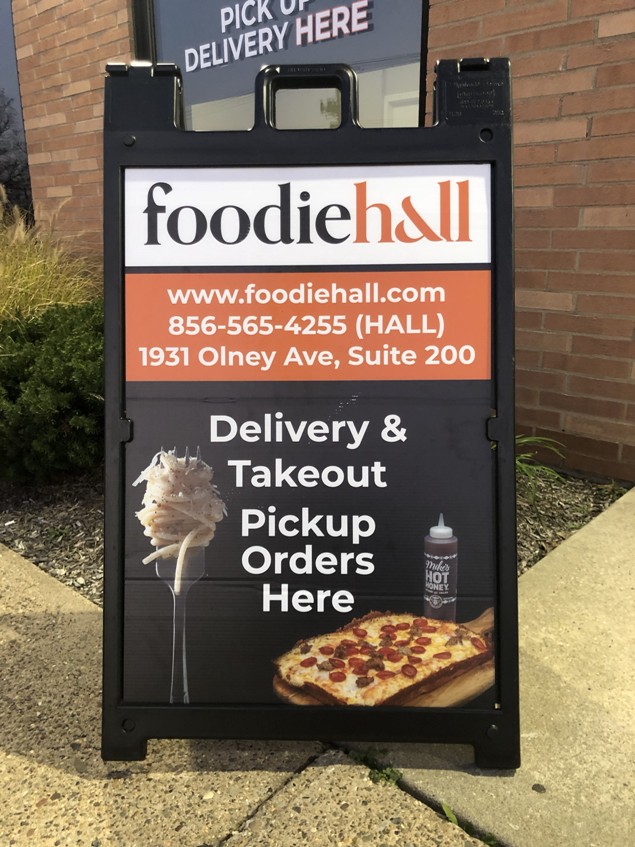
Hall of Food
The new Foodie Hall in Cherry Hill is a revolutionary concept – first rate food prepared specifically for takeout and delivery, while offering something for every taste.
For you JerseyMan readers and Legacy Club faithful, since membership has its perks, we’re about to share privileged information with you. If you’re on a plane or train, check that no one is looking over your shoulder, and that there are no surveillance cameras nearby. We’re entrusting you as someone with a need to know.
Here it is: You can now get a Geno’s cheesesteak in South Jersey.
Okay, maybe it doesn’t sound that momentous. Tony Luke’s, Primo, DiNic’s and other iconic Philly sandwich shops have all opened outposts across the Delaware, sparing their enthusiasts in our neck of the woods considerable congestion.
But for Geno’s, expansion from its 56-year South Philly location has been minimal. You can find a couple of locations in the city, like the airport. But until very recently, a Jersey dweller had to pay bridge toll to sample a Geno’s cheesesteak.

It’s the meat. Geno’s won’t have it any other way.
Dan Goldberg, co-owner of the Foodie Hall in Cherry Hill that now offers the essential Philly sandwich, helped to make this unprecedented happening possible.
“We’re very excited about it,” Goldberg says. “Our PR firm had a relationship with Geno, and made the introduction. We pitched Geno on the idea, and surprisingly to us, he was receptive.
“Geno’s has never expanded outside of Philadelphia, ever. So for us, this was a really exciting opportunity. Geno toured our facility, was very impressed with the layout, the cleanliness, and the whole thought that we put behind it, and said he was interested.”
And so you know, Goldberg didn’t just throw a few bucks at Geno Vento to use his signage. Thankfully, Geno is more protective of his brand than that.
“We worked out our deal, and went through extensive training with Geno to make sure that the Geno’s steak you have here in Cherry Hill is the same Geno’s steak you’ll have in South Philly. Which is not only important to us, but obviously important to Geno as well. It’s literally his name on the marquee.
“Geno was adamant, because he’s approached all the time, he wants to make sure there’s consistency across his locations.”
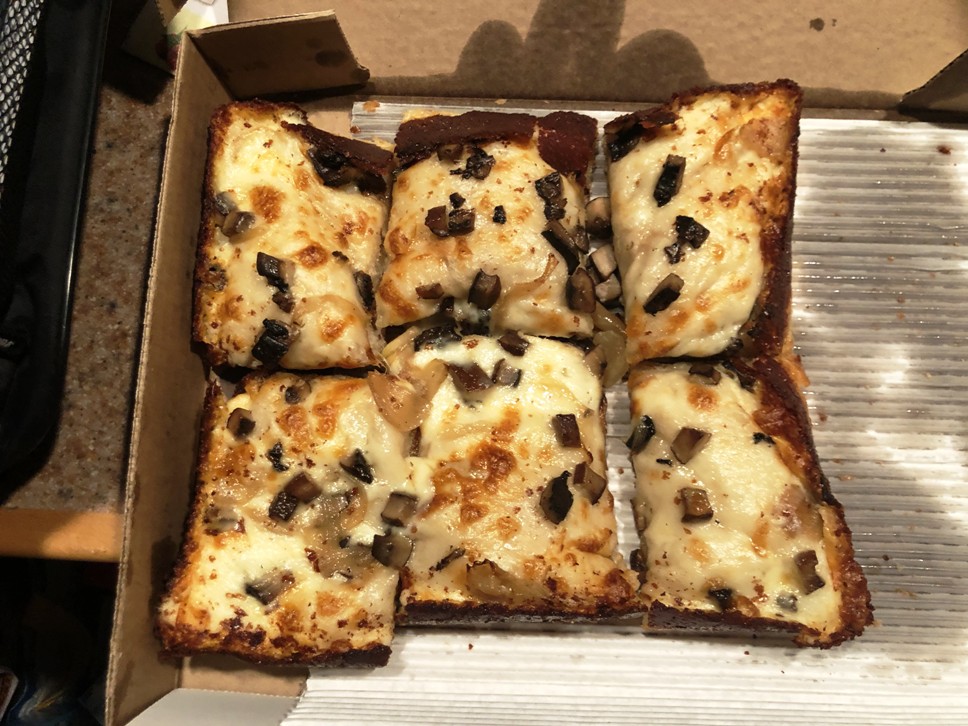
Not just Detroit-style pizza…Detroit-style pizza created by a gourmet chef.
To successfully persuade Geno’s to be a part of Foodie Hall is obviously a significant accomplishment. But it gets better.
Foodie Hall opened for business in May of 2022 offering a novel idea…multiple types of cuisine available for takeout and delivery. No more settling, they proudly proclaim. If your family bickers frequently over what to get for dinner, or your sports watching buddies can’t decide between pizza or burgers, Foodie Hall is your solution.
To be sure, maybe any-cuisine food delivery isn’t what you’d call a novel idea these days. As many restaurants in New Jersey were forced to close in response to a virus, many of them were offering takeout and delivery options to stay viable. If your local diner was doing this, you could probably choose from a varied menu and have DoorDash or GrubHub bring it to you.
Foodie Hall is revolutionary in being designed for the purpose of delivering higher quality food…whether it’s tacos, chicken sandwiches, or dumplings. Hop onto their website and order from menus that include Detroit-style pizza, Korean BBQ burgers, chicken Quesabirria burritos and much more. All chef-inspired creations.

Since the pandemic, the trick is to keep food warm.
In case you’re wondering, Foodie Hall wasn’t conceived during the pandemic. But the sudden pivot towards takeout and delivery definitely gave the idea a boost.
“In 2018-19,” Goldberg remembers, “my original founding partner (Nick Ballias) and I, we met at a food event that I co-chair, called Men and Women are Cooking, that raises money for the Atlantic City Boys and Girls Club. This was when GrubHub, Uber Eats and DoorDash had come to Atlantic City, and it was starting to blow up.
“We started coming up with an idea for a delivery-only restaurant. We had penciled this out already, and then Covid hit and restaurants closed, and all of a sudden everyone was ordering delivery.
“My parents were telling me how they had ordered Morton’s for dinner. That’s when it struck me, there are people whose consumer habits have now changed and will never go back. It’s no longer just wings and pizza. There’s my parents, who are not exactly the most tech savvy, ordering steaks for dinner, that means anybody can be ordering everything.
“So why not come up with a restaurant concept that had multiple different types of cuisines on it? We ran into this family idea, where the parents want adult food and the kids want pizza or mac and cheese. Or the parents can’t agree. Or you have a group of friends watching football and they all want something different. Rather than settling, let’s have something for everyone.”

The conveyor belt. It seems so obvious if you’ve owned a dry cleaning business.
Sounds great, but how could that all work? A conveyor belt is a big part of it (!), but Goldberg says every step of the process matters.
“We put a lot of thought into what delivery trends were taking place, what was working and what we saw that wasn’t working,” he remembers. “Packaging was a big piece of it. Many restaurants during the pandemic that were doing delivery kind of out of necessity were using takeout packages. Those packages are not meant necessarily to be reheated, or to be leak proof, or to sit in a car for half hour or to retain heat or cold.
“We looked at packaging specifically meant for delivery. We wanted something that would maintain heat and not leak. We literally made products in our kitchen, put them in different containers, and had them sit in our parking lot for half hour or drive around and see how they held up. We wanted packaging that would be eco-friendly, and also able to be reheated in microwaves and ovens and things.”
Then there’s the little matter of creating a wide variety of cuisine from one kitchen, maintaining quality, and somehow keeping overhead down.

Some ingredients are astoundingly versatile.
“We are very conscientious in the ingredients we use to be cross-utilized across all the platforms. For example, chicken breast is used in multiple products across the different restaurants. I have a chicken parm sandwich at Criss Crust, and we have the chicken sandwich concept, Simply Fowl, and then we have salads that have grilled chicken on them. We’re trying to use things across and that keeps us more efficient.
“When we designed the kitchen, we were concerned with having a traffic issue, with people walking around and bringing all the various foods to the front. It would have been a waste of labor. We came up with a solution which I borrowed from my old business…a commercial laundry business…where we had a conveyor belt. It’s a 120-foot conveyor belt that runs down the center of our kitchen.
“I don’t need people running up to the front and bringing the food, I don’t have to worry about people walking into each other. It’s a way to keep costs down and keep order in the kitchen.”
The conveyor belt concept is indeed impressive to witness. An owner of a busy diner might see it and wonder how in the world they didn’t think of it.
“No one’s ridden on it yet that I know of,” Goldberg jokes.
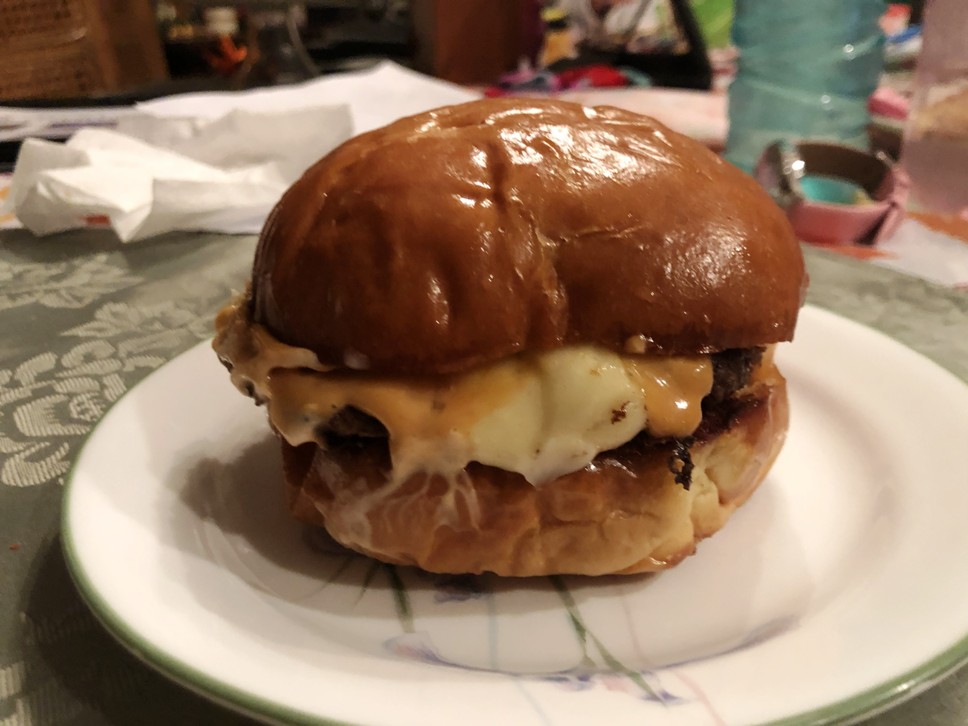
Craft burgers. Just because craft burgers.
JerseyMan loves telling readers what makes life in South Jersey great and highlighting business ingenuity among our own. Places like Foodie Hall give us plenty to work with.
In the days before smartphone maps, you might have had a difficult time finding the place. It’s situated in an industrial park in Cherry Hill, just off of Route 70 but requiring navigation of annoyingly tricky jug handles and intersections. If it were a sit-down restaurant, the difficulty getting there might be a factor in your going elsewhere.
But for this style of eatery, the location is the beauty of it.
“We are delivery and takeout only,” Goldberg says. “We need to be near people, and we need to be near businesses, but I don’t need to be on Route 70 or Route 73. I just need accessibility, I don’t need visibility. We built out this really high-end large kitchen, with the latest and greatest in equipment, but I’m not paying the prices I would pay to be on Route 70 or 73. It’s more economical to be here.”
Market research drove the location of Foodie Hall’s first outpost in Cherry Hill. Even though it seems obvious.
“Between Cherry Hill and Mount Laurel and Maple Shade, you have a tremendous number of people that are foodies. It really fit well for us.
“It has a great mix of residents and businesses. We can cater to people in their homes at nights and weekends, and our concept lends itself perfectly to office orders and catering during the day. We’re getting a lot of offices that typically order once a week, same idea as from home. Instead of having 20 people fighting over what we’re having for lunch, now 20 people can get what they want in one delivery.”
Including an authentic Geno’s cheesesteak, without the tolls and traffic.

“Wow, you can get DaNick’s here?”
Establishing The Brand(s)
Foodie Hall features eight restaurants under its umbrella as this sentence was written, including Geno’s Steaks, an instantly recognizable brand to Philly area natives.
You can order Mexican street cuisine from Dando Tacos, Jersey fried chicken sandwiches from Simply Fowl, craft burgers from DaNick’s, Buffalo chicken mac and cheese from Mac N Toastie, or vegetable dumplings from the Cantina Wok & Noodle Bar. If you’re going Italian, try the Criss Crust Detroit-style pizza, or the antipasti from the Fornire Italian Kitchen.
Seeing the choices, a South Jersey food enthusiast could wonder how they have lived here so long without recognizing the catchy names and logos sitting alongside Geno’s. How does anyone miss Mac N Toastie?
When questioned whether the others are established eateries in their own right, Dan Goldberg considers it a triumph of Foodie Hall’s design.
“I’m glad you asked that,” he explains, “because they’re not. The fact that you asked that question means we did a good job of branding and trademarking to look like they are established brands. And the idea is that these brands will proliferate and open up in other Foodie Halls.
“There was a lot of thought given to the name, the logo, the design, the color scheme, to make it look like a franchise or an established restaurant. But they’re all our own creations, we came up with them. We put the menu together, the recipes, etc.”
That includes DaNick’s, which sounds perilously close to DiNic’s, the long established roast pork sandwich destination in the region.
“No, different name,” Goldberg responds when asked about the similarity. “They’re actually named after (co-founder) Nick (Ballias) and I, Dan and Nick. Nothing to do with them, we love their sandwiches, but yes, completely unrelated.”
So foodies in the area can rest easy knowing that they haven’t missed out on Fornire’s, and a potential topic for their blog.
But if you’re one of those types, the clock’s ticking on trying out Foodie Hall before your blogosphere competitors do.

You’re probably pretty good at cooking if you’re seen with this guy. (photo courtesy of Georgeann Leaming)
Key Players – Georgeann Leaming
Dan Goldberg and co-founder Nick Ballias don’t mess around when it comes to takeout fare for discriminating South Jersey natives. While working out the plans for Foodie Hall, they considered product quality important enough to bring a chef on board to be a culinary consultant, and design recipes for their menu of food creations.
Not just any chef, by the way…they partnered with Georgeann Leaming.
You may have heard of Leaming…she’s been a champion TV chef on Food Network’s Chopped, and competed on Hulu’s Man vs. Master. She’s been an executive chef for two of Gordon Ramsey’s restaurants, and has co-owned two food stops in Philly. One of them, Samwich, took Philadelphia Magazine’s “Best Fried Chicken Sandwich” prize in 2016.
That’s just a partial list of Leaming’s street creds in Philly area cuisine, but it’s enough to see why Dan and Nick would take the opportunity to work with her.
“It was very important for us to not simply have your average burger or chicken sandwich. We try to do everything higher end than your normal delivery would be.
“She left to pursue some other avenues in September, but she was with us all the way. She helped us design the menus, and some of the dishes were completely her own from top to bottom in terms of the ingredients, the recipes and everything. These are recipes that we use, and we haven’t changed anything since she left.
“Georgeann was a big help,” Goldberg acknowledges. “Fantastic, talented chef, culinary director, and really helped design and get this to where it is. Perfect person for this, and without her, we wouldn’t have the type of food that we have today.”
The decision of what to get for everyone in the room isn’t the only comestible conundrum Foodie Hall solves. If you’re looking for cuisine inspired by a top chef in the region without the triple-digit price, they take care of that for you too.
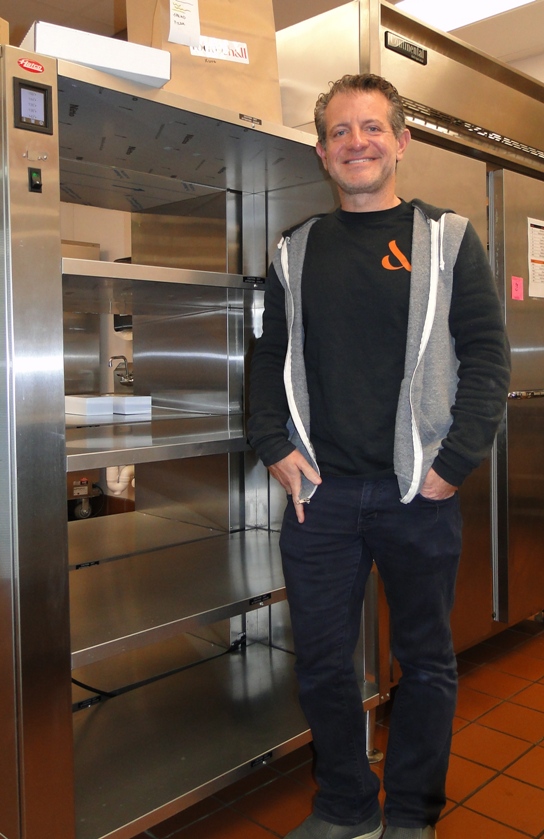
Dan Goldberg, FoodieHall co-owner, feeding people everywhere.
Meals 4 Meals
Dan Goldberg and his people consider giving back to be part of the ethos of business success, and they offer an incentive to philanthropic types who love great food. For every meal ordered from Foodie Hall, they donate a meal to Feeding America through their Meal 4 Meal program. On Foodie Hall’s website, they call the initiative “a vitally important guiding principle in how we operate.”
Goldberg is happy to explain how it works. “What they do is, they will take a monetary donation that they get a lot more mileage out of than we would, because of their immense buying power. We donate an amount to them for every meal that we sell, which is the meal equivalent for them. They use that to purchase meals for their partner charities, which are all across the country and the world.
“We initially got the idea from the Bombas Socks people. For every pair of socks that they sell, they donate a pair to people in need in a country outside of America. And we loved the idea. It made a lot of sense to us.”
So when you order from Foodie Hall, you’re not only providing all your guests or employees something for their own tastes, you’re making a contribution to a four-star organization with 200 food banks and over 60,000 programs to help feed the hungry in your own homeland. Not that you need any extra incentive to try Simply Fowl’s Nashville fried chicken sandwich, but it doesn’t hurt.
“By our calculations,” Goldberg estimates, “We’ll be donating about 50,000 meals in this year, which is really exciting. I’m very proud of that.”

Collectors And Sons – The CollX Sportscard App
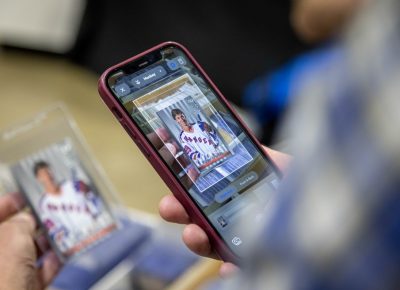
JerseyMan sent me to interview Ted Mann and talk with him about his new app, CollX, which helps sportscard collectors easily find the value of their cards. Love fun assignments like this! You can read the article on JerseyMan’s website here, or view the PDF from the magazine here.
(All photos courtesy of Ted Mann unless otherwise indicated.)
Collectors & Sons – The CollX App
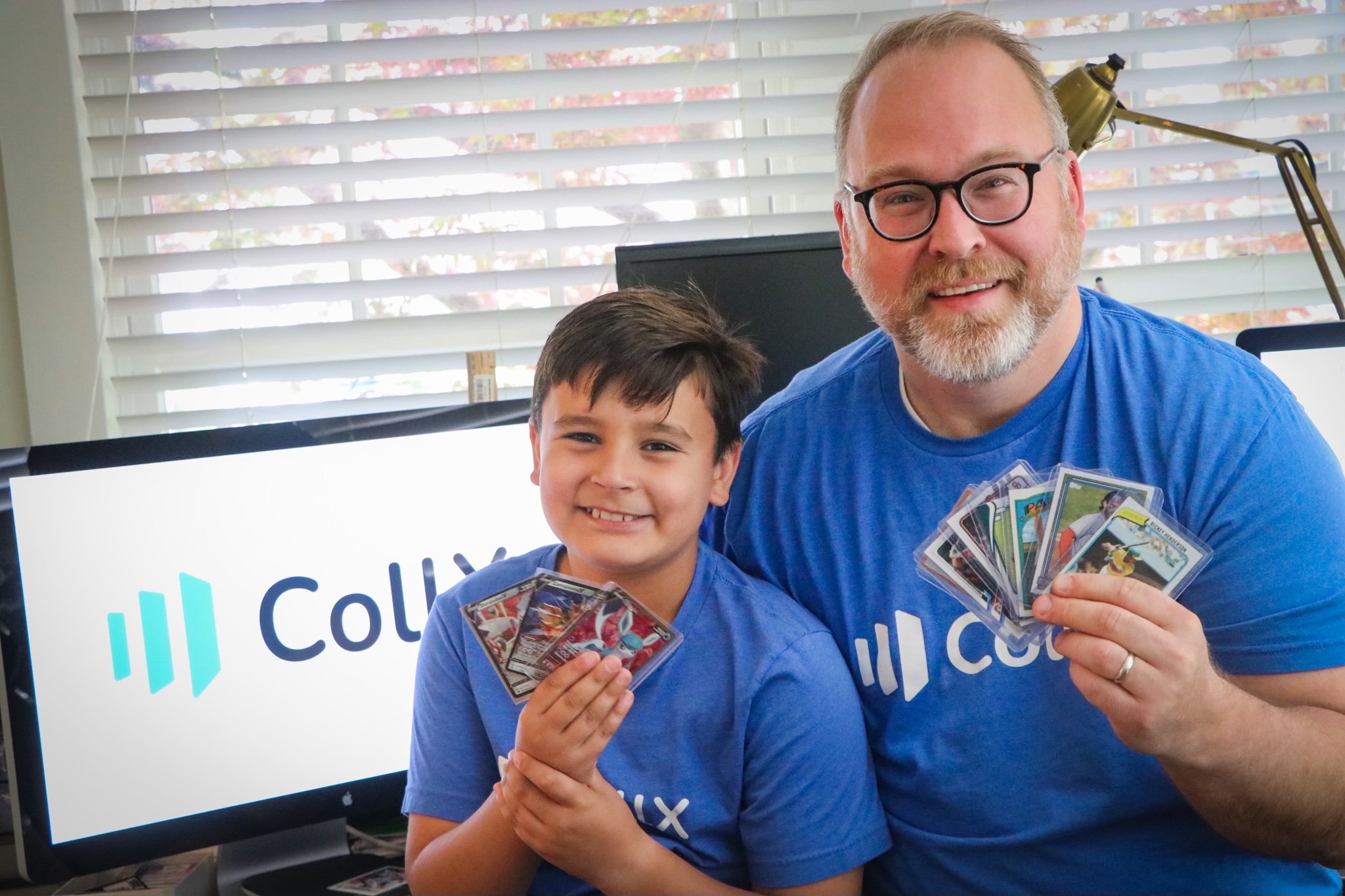
Two geniuses at work.
There is a new app available for sports card collectors that solves a decades-old problem…finding out how much your sports cards are worth. It’s called CollX, and the idea was hatched by a ten year old.
The wonderful thing about young children is that no matter how overwhelming a problem, they always see a simple solution.
And as any sportscard collector knows, finding the true value of cards is a pretty overwhelming problem.
Ted Mann, a former journalist, has just started his fourth technology company using visual search technology. It’s an app called CollX, and it’s an idea that is so obvious that adults need kids to help us see it.
Fortunately, Ted has just such a visionary living under his roof…his ten year old son Charlie, who saw how his father’s technical skills could make the world a better place.
The CollX app does the most important thing apps do…it saves collectors lots of time. With CollX, you can dig out that dusty collection of sports cards from your attic, scan each card, and instantly see its approximate worth. (Incidentally, if your cards are worth anything, hopefully you’ve been wise enough not to let them collect dust.)
No more poring through Beckett or Tuff Stuff guides, no more hauling your collection to a broker, no more countless hours on eBay. Ted and Charlie tried all those things with their collections, until Charlie suggested a better idea.
Ted gives all the credit where it’s due.
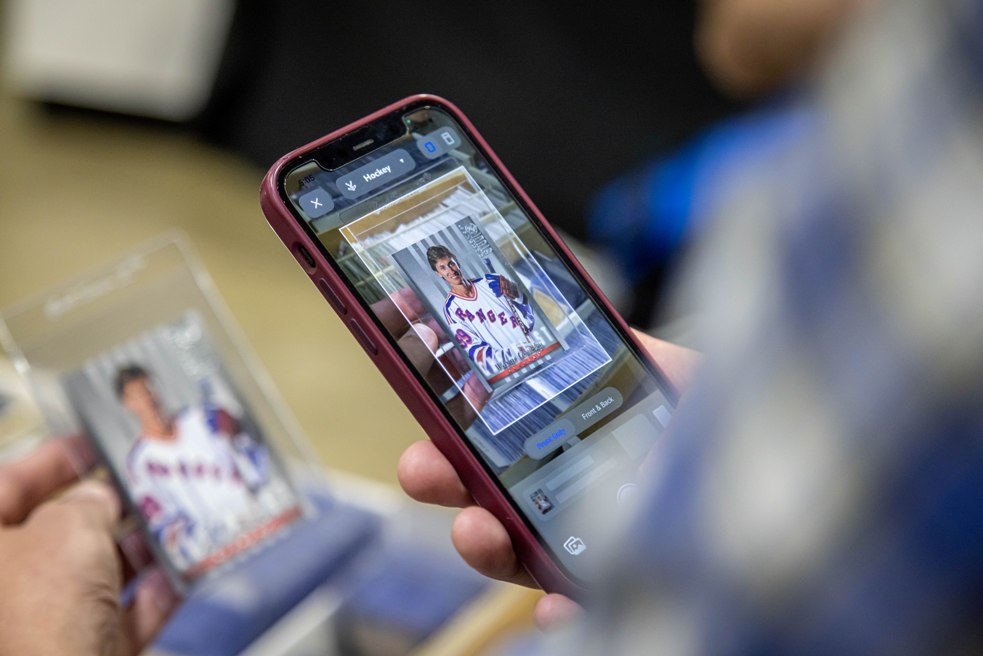
It’s obvious enough that we need a child to think of it.
“When I was a kid, I ran into the same problem that Charlie had. Tuff Stuff Magazine, listings and prices, I also used Beckett back then, looking things up manually.
“But the Beckett Guide has become like a phone book. It’s super thick. It’s really, really tough and time consuming to look these things up, and even when you do, I was finding that the prices in the Beckett Guide, probably the minute they’re published, are out of date.
“We found some apps where you could look up cards, but they were really expensive, high value cards, which sad to say, did not fit the description of my collection or Charlie’s.
“We tried one thing after another, and finally Charlie’s like, “Dad, can you just build me something that would do this?”
Cue the light bulb.

Baseball card valuation on the fly.
Childlike vision works because adults can’t believe some things can be easy, like finding the actual value of a Cal Ripken Jr. rookie card. As a result, many of us let valuable memorabilia collect dust in the attic.
Charlie provided the inspiration, but as Jersey native Thomas Edison informed us, genius is 99% perspiration. Ted is well aware of this, and he’s been putting in the sweat. CollX is all about making a difficult and tedious process easy…but developing the app itself has been anything but an easy process.
It’s not the easiest to market research, for one.
“It’s easy to go and ask people around town, do you have any cards? ‘Yes.’ Do you know what they’re worth? ‘No.’ Have you ever sold a card on eBay? ‘No.’ Why not? ‘I don’t know what they’re worth.’
“It definitely gave me optimism that there was something big here. But understanding how big a market it is was a challenge. We did assess that basically, thanks to eBay and other marketplaces. The current market size is about 5.4 billion.
“But what about all those people that have never sold on eBay? Could you get them to do it? Could you get them reacquainted with their cards and back into the hobby?
“We actually had to conduct a pretty big omnibus study to get a sense of that…just this afternoon, another news outlet called New Street published the findings of our research. The big takeaway was that there are about 85 million American adults that own trading cards.
“It’s a huge 33% of the population, and yet none of them, or I should say a small percentage of them, have ever transacted on any kind of market like eBay. The thing blocking them isn’t necessarily getting the cards graded or having access to a place to sell them. There’s still a lot of card stores, there’s a lot of online sites. It was simply not knowing what the cards are worth, and not having a good way to figure that out.
“If we can help solve that problem, then this huge addressable market can be unlocked.”
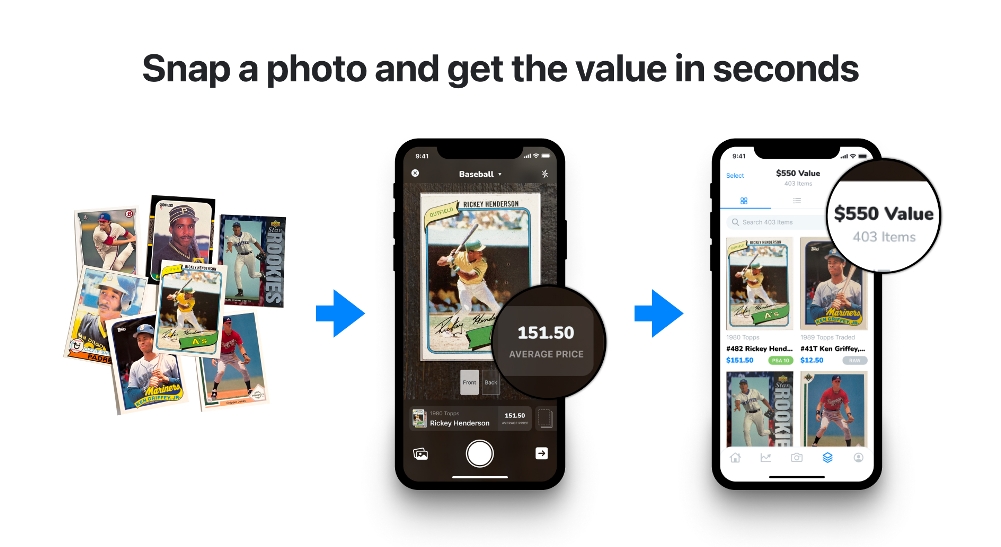
That thick book is why people didn’t bother.
There is also the sheer number of collector’s cards…the CollX database features 20 million, and most definitely counting.
It’s an ongoing process, Mann says. No kidding.
“We still don’t have every card by a long shot. There’s a few cards in my collection that I still can’t scan into CollX, because we haven’t gotten those images or gotten that data into our database yet.”
Spoken like a true entrepreneur…20 million is nowhere near enough. Just how, exactly, does a database of 20 million sportscards get constructed?
“We found a number of sites online, all publicly available sites, that have checklists. In the trading card world, you can build the set, right? And there’s a list of every card in that set. We started building those checklists, and then populating all the images for all the cards in those checklists.
“We started with baseball and then we added football, baseball, basketball, hockey, soccer, wrestling. Soon we’re gonna add trading card games like Pokémon.”
Mann says that they have also developed what he believes is a generally accurate algorithm for determining each card’s worth.
“We’ve built up a ton of pricing data, most of which is coming from other auction sites. Again, publicly available and all readily searchable, eBay being the biggest. We’re taking all of those transactions and mapping those back into the individual cards.”
Arduous task, undoubtedly.
But the CollX app keeps improving, and its usage keeps growing.

One of over 200,000 users at a given time.
During JerseyMan’s interview with Mann, a counter sitting on a nearby shelf occasionally made clicking noises and changed the number it was displaying. This counter, Mann explained, shows the number of people using the app at a given time. At that moment, the number was 232,408 and growing. There are plenty of curious collectors out there.
But Mann and Son’s E-Z Sportscard Valuation Service has bigger plans…not just helping users find the worth of their cards, but also facilitating the sale process if they are inclined, and ultimately monetizing the app through commissions.
“We’re a very early business,” Mann says. “We aren’t charging for the app. We know there are already users reaching out to other users to buy their cards…we see that happening in big numbers. We’re going to help them do that better, so we’ve created a number of tools.
“The first big tool is our deals feature, where you can negotiate on multiple cards. You can create a deal with a bundle of cards and negotiate on the lot. We’ll facilitate checkout and generate shipping labels, to ship the cards via the postal service.
“We want to help people make a lot of money on their collections. But the thing I think is really unique is, on CollX, you actually see what the buyer and the seller both have in their collections. That enables us to say, here’s the areas where you have a shared interest. If you really like the Phillies, Bryce Harper, we’re gonna surface those cards from my collection. When you add something from my collection, now here are a few other suggestions of other cards you might be interested in.
“We can build those recommendation systems in a really personalized way, and I think it creates a better experience.”
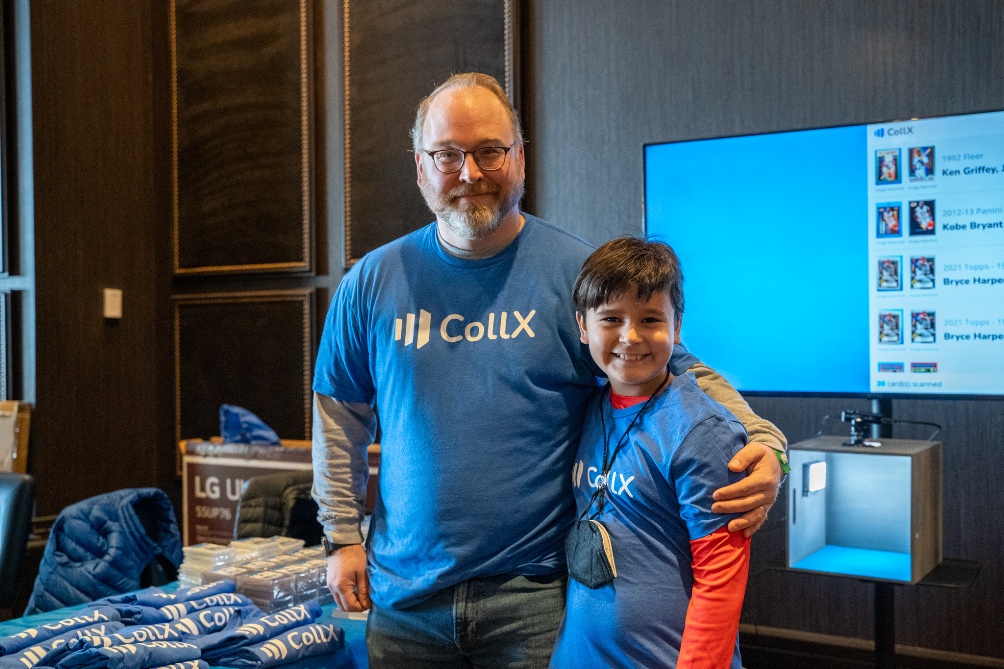
Father and son bonding through baseball cards…it’s as American as it gets.
There are few better opportunities for fathers to tell their sons about athletes of their era than when leafing through a collection of sports cards. Imagine building a business around it with your son. Charlie Mann is getting a solid grounding in both…even if he still gets more stoked about interviewing Rickey Henderson, which he did at a recent sportscard event.
Charlie is obviously not old enough to remember baseball’s greatest base thief, but as Ted says, he knows plenty about him.
“He was super excited to talk to him, because that was one of the cards that he pulled out and he was like, ‘Dad, is this one worth anything?’ I was like, ‘That might actually be the most valuable card in my collection. It’s his rookie card. Let’s go try and figure that out.
“And sure enough, it was one of the more valuable cards. So when Charlie got to interview him, he shared that story. Rickey was really nice. I was really impressed with him.”
“I love getting to do this with Charlie,” Ted continues proudly. “It’s been a great way for us to bond and connect, and it’s not just us. I’ve noticed and seen and heard from countless users on the app that it’s been the same thing for them. Just fathers and sons, getting to bond over collecting cards and to do this together. I think for Charlie that was super gratifying too. To see it wasn’t just him that had this problem.
“And he’s helping all these people.”
Sometimes, the kids really do have the answers.
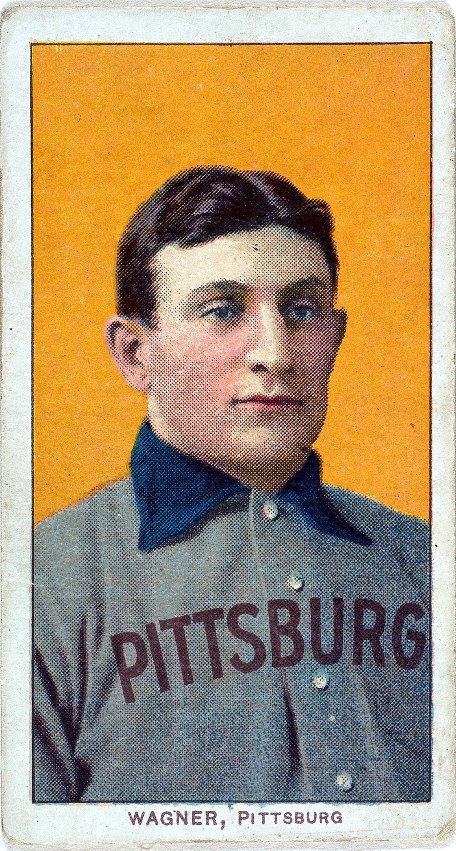
No, you can’t sell a picture of the card. (image courtesy of Wikimedia)
The Honus Wagner Card
As every baseball card collector knows, the T206 Honus Wagner card is the most valuable baseball card in history. In August of 2021, the card sold for a whopping $6.6 million.
Why is it so valuable? According to Wikipedia, in 1912 Wagner was asked permission by the American Tobacco Company, who manufactured baseball cards at the time, to have his visage included on a card. Wagner refused for reasons that still aren’t clear today, with theories ranging from his not wanting to advertise tobacco to kids to his being a tough negotiator who demanded greater compensation.
As a result, just 50 to 200 Honus Wagner cards were produced, and given his stature on a baseball field, this almost immediately made the card valuable.
Ted Mann well knows the value of scarcity in collecting. It was unintentional in the American Tobacco Company’s case (then again, maybe it wasn’t), but Mann says that card trading companies do intentionally create scarcity.
“The manufacturers of these cards create small print runs for certain cards. They’ll say, there’s only ten of these cards. It’s like your golden ticket. Golden auctions sold, I think a one of one Mike Trout rookie card for like $5 million. There’s only one of them, so that creates demand.
Mann doesn’t believe a Honus Wagner card will be scanned on CollX. He stresses that the app is more for “the rest of us”.
“I don’t think we’ll see a lot of $7 million Honus Wagner cards scanned in the collection. As much as I’d love to cater to the high end of the market and have them see the value on the app, I think it’s really kind of the rest of us, the long tail of the collecting hobby that we’re really appealing to.”
The value of some cards brings to mind a potential problem that Mann is also working to address: potential forgeries.
“It’s difficult, forgeries of cards is a tough thing to identify with just a picture, especially if they’re pretty much identical. Obviously, you wanna take a picture of the card and if for some reason you do receive a fake and you’re able to see that, you can report that. And we would not release the payment to the seller if they were peddling fake cards.
“I think there’s definitely some things that we can do to double verify it. But we will protect the buyer and make sure that they get the cards they paid for.”
Something to remember just in case you find yourself seeing a Limited Edition Honus Wergner card for sale.
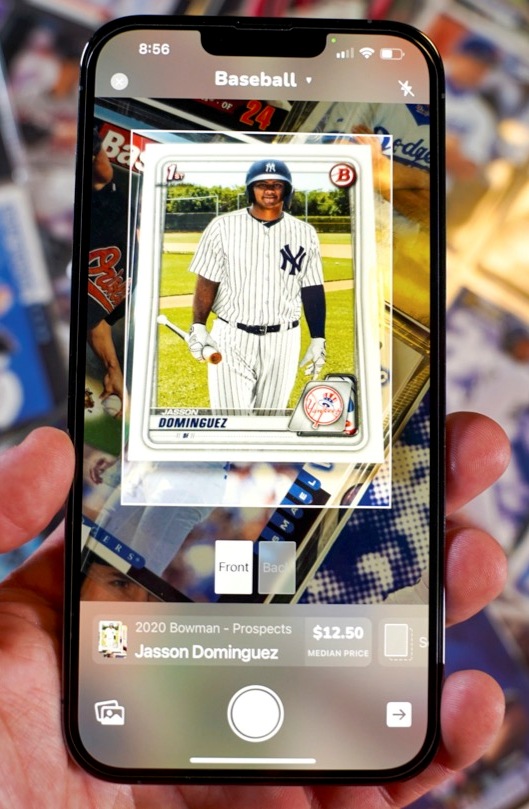
Yes, it looks like him, but let the image recognition decide.
Image Recognition – The Key to CollX
Ted Mann is an expert at how image recognition, a remarkable technology that CollX employs to determine what sports card it’s looking at. His son, of course, was aware of this when he suggested the idea of using it for sports cards.
“What we’re doing with CollX is a specific breed of image recognition that is sometimes called reverse image search, or reference image matching, where we have an existing reference image of a card. We’re trying to match the picture of the card that somebody’s taken on their smartphone to an image in our database.
“Think about it almost like matching fingerprints…when you’re matching a fingerprint, you don’t necessarily need to match everything about the fingerprint. You’re looking for the little variations that kind of define it. We kind of do the same thing. We have a deep learning model that is trained to identify specific features within each card image, and then we’re just trying to match up one to one.
“Imagine if the trading card itself was a QR code. And you’re basically just identifying that and matching that to an existing one in the database to get that one to one match.”
The explanation of the technology obviously goes much deeper, but Ted’s happy to take care of that for you so you and your son can scan your cards.

Be a part of the sportscard valuation community…
The Collector’s Community
Ted and Charlie and partner David Grzybowski recently attended a sportscard event in Atlantic City, where they were quite well received…and encouraged.
“I met probably a thousand people at the national in person who just really love the app. A couple of them came to me with a laundry list of features they’d love to see, which is great too.”
Incidentally, the audience for JerseyMan might find CollX right up their alley. “There’s a high overlap rate of entrepreneurs and card collecting,” Ted says. “It’s actually kind of a funny, it’s how a lot of them got started. I guess myself included.”
To Mann, the enthusiasm for CollX is an opportunity to improve things in the app, such as the accuracy of pricing, which has limits coming from auction sites where prices can vary.
“A lot of our data relies on eBay transactions and a lot of eBay transactions are bogus, we’ve learned. So when those happen, just helping us kind of prune those out. We’re actually gonna have an app update pretty shortly that gives some of that functionality so that our users can help us with that.
“We’ve done our best to come up with ways to average the prices or estimate the prices if needed. But the truth is we need help and we have 232,000 users, many of whom don’t mind putting in a little bit of extra effort to help us.”
Entrepreneurs who listen should be valued. CollX’s customer service is already an improvement over both of the TV providers in my area.
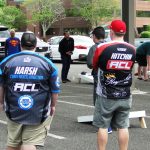
Professional Cornhole – Beyond The Parking Lot
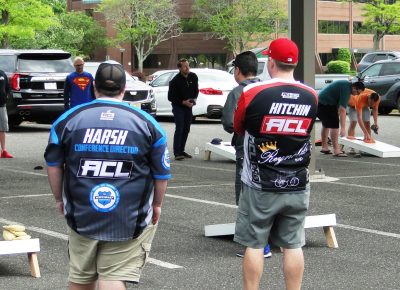
JerseyMan asked me to cover a local cornhole event they arranged, and to work in a piece about the phenomenal growth of professional cornhole in the midst of the COVID-19 pandemic. Hope you enjoy it. You can also view the PDF of the article here.
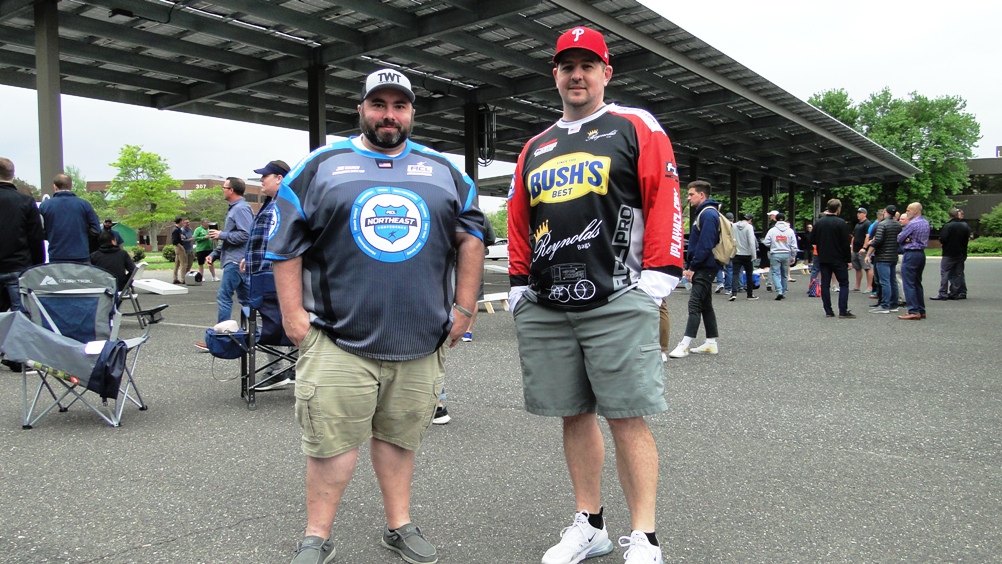
Professional Cornhole guys.
Beyond The Parking Lot – Professional Cornhole
You can write for JerseyMan and attend Legacy Club events for ten years, and almost never see Ken Dunek animated enough to shout loudly and pump his fist.
Then again, you don’t see many people gain a lead against John Kitchin in a cornhole match, however short-lived that lead may be until Kitchin finds his bearings and starts effortlessly nailing throws. It’s understandable for even a reserved person to be thrilled at the achievement.
This anomaly was at the Infinity Club Cornhole Tournament, held this May at the PCS facility in Moorestown. The event raised nearly $4,000 for the Leukemia & Lymphoma Society, and for survivor T.J. Smink’s bid for the Society’s Man or Woman of The Year.
Of course, many esteemed Legacy Club members were present. It’s an ideal opportunity to avenge a recent defeat on the golf course. No one tanks, of course, but a loss isn’t so bad…it’s an opportunity to grab a drink and catch up with fellow members.
One would think that, in a crowd of Eagles fans, who have to have considerable tailgating experience, there would be some players standing out in the crowd. But other than Smink’s team, who prevailed in the match, most of them were unexceptional shooters. Even by frequent tailgater standards.
The tournament was for fun and to help less fortunate people. PCS’s parking lot is obviously no billion dollar, luxury box-filled venue.
But professional cornhole has grown well beyond the parking lot.

Apparently, everyone else forgot their uniforms.
Present at the gathering were Kitchin, a national cornhole pro who resides in West Deptford, and Joe Harsh, the American Cornhole League’s (ACL) Northeast Conference Director.
Yes, there is a nationwide professional cornhole league. As seen on TV.
Before 2020, the ACL had already landed some national television deals, and events could be seen on various sports networks. Then they got a boost…professional cornhole became one of the rare entities that benefited from an outbreak. With no baseball, football, basketball, hockey, etc., there was a fairly ginormous hole in sports broadcasting to fill.
So cornhole moved into seriously choice TV slots. Harsh notes that “We had eight to ten broadcasts on Saturdays, prime time with our Pro Division, and traveled all over the country.
“We’re really fortunate,” he adds. “Everything went well for us. And the exposure and the growth, it’s been really, really beneficial to the league.
“I’ve known John for a couple years now, and the fact that someone would ask John for an autograph, it’s the coolest thing.”
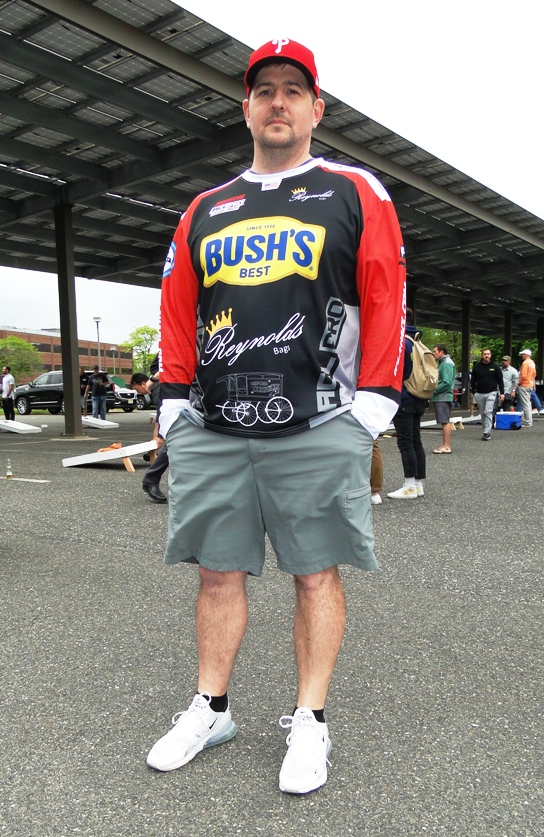
John Kitchin, who is probably better at cornhole than you.
Kitchin has been known to drive to Cincinnati for the day to throw bags. At least, that became a thing for him when someone noticed he was a pretty good shot at tailgates.
“I played in the parking lot of Eagles and Phillies games, and a guy came to me and said, ‘Hey, we have a league for this.’ I kind of laughed at him. Here I am seven years later, and if I could play more I would.”
Indeed, Kitchin started playing in a league, and did well enough to compete in local tournaments. Then he became a pro. Then an ACL Pro.
He’s added some impressive achievements to his league bio…#1 Northeast Conference player in 2018, ACL Man of The Year in 2019, and a 2nd place finish in the 2020 USA Cornhole Club Championships – broadcast on NBC Sports – to name just a few. He’s so good that Bush’s Baked Beans and LG have put their logos on his jersey.
You can see why even Ken Dunek would celebrate well beyond his typical demeanor scoring a lead against him. Which, to Kitchin and Harsh, is part of the appeal…anyone can play, even against the pros.
“I play in leagues around here all the time,” Kitchin says. “I play pretty well, but there’s a lot of people who, when they play against me, they use that as a measuring stick. I don’t beat everybody, so I think that makes them even more interested…‘That guy’s been on TV!’”
“That’s the coolest part,” Harsh adds. “You can see him on TV on the weekend, and then Monday or Tuesday night you could literally play against him.”
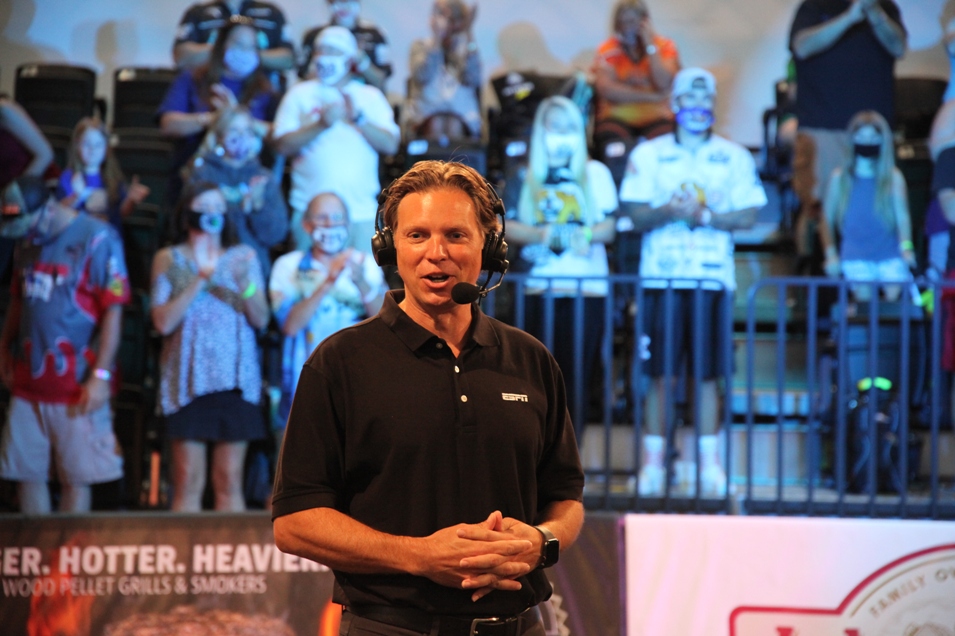
Professional Cornhole announcer Jeff McCarragher, offering his well thought out insight about a match.
(photo courtesy of Jeff McCarragher)
Jeff McCarragher is a freelance sports broadcaster. His LinkedIn profile describes his most recent position as a “Play-by-Play Announcer for College Football & Basketball…and yes, Cornhole too.” His resume covering other sports is impressive, but by most any measure, McCarragher is the Voice of American Cornhole.
He landed the gig by simply being in the right place at the right time. Literally.
A South Carolina resident, he worked college football and basketball throughout the Carolinas. Tupelo Raycom, the company that brought him announcing work, had an office there. And they knew ESPN needed a cornhole announcer.
“When COVID hit, being a freelance play-by-play broadcaster was like being a waiter or server at a restaurant,” he remembers. “We were shut down immediately because all the sports just went away. When they got the contract on ESPN, they called me and said, ‘Hey, are you willing to travel if we put together cornhole through the summer?’
“I had done a little bit for them in the past, I’d done the national college cornhole championships that previous New Year’s. I said, absolutely, I’m comfortable traveling. And so away we went, ESPN signed a deal with the American Cornhole League.”
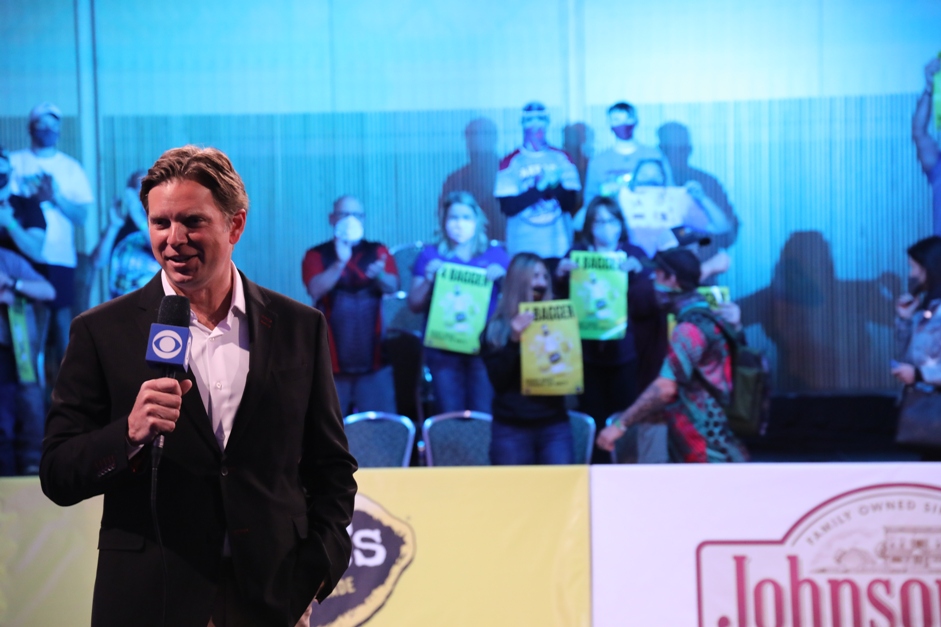
No, those aren’t protestors. They’re cornhole fans.
(photo courtesy of Jeff McCarragher)
McCarragher’s enthusiasm for covering professional cornhole of all things is palpable. The players may not have toiled through college or minor leagues, but they definitely have well-developed skills.
“It’s a very simple sport, right? You just slide it up the board and put it in the hole. But just like any other sport, when you get to a very high level, you start to learn how technical it is. I had to learn a whole new vernacular, whether it’s replacement bags or grab bags, the way a player collects the bag.
“I relate it to being a really good major league pitcher. He’s got his fastball, his slider, his cutter, his change-up. The ones who play at the top level, they’ve got a little cut shot, they’ve got an airmail shot. They can make the bag curve one way or another, they can angle it and get the bag to kind of roll. Instead of different pitches, they have different technical shots that they can throw. It’s really pretty amazing.”
There’s considerable tension in big matches, too.
“It gets to be like golf,” he continues. “You’ve got a two-stroke lead, or maybe a one stroke lead, going into the 72nd hole on Sunday. I don’t care who you are. That final tee shot on the 18th? It has to be good. There’s so much pressure. Again, I get it, it’s cornhole. We’re not talking about the Masters. But it’s still competitive, the desire to win for these players.”
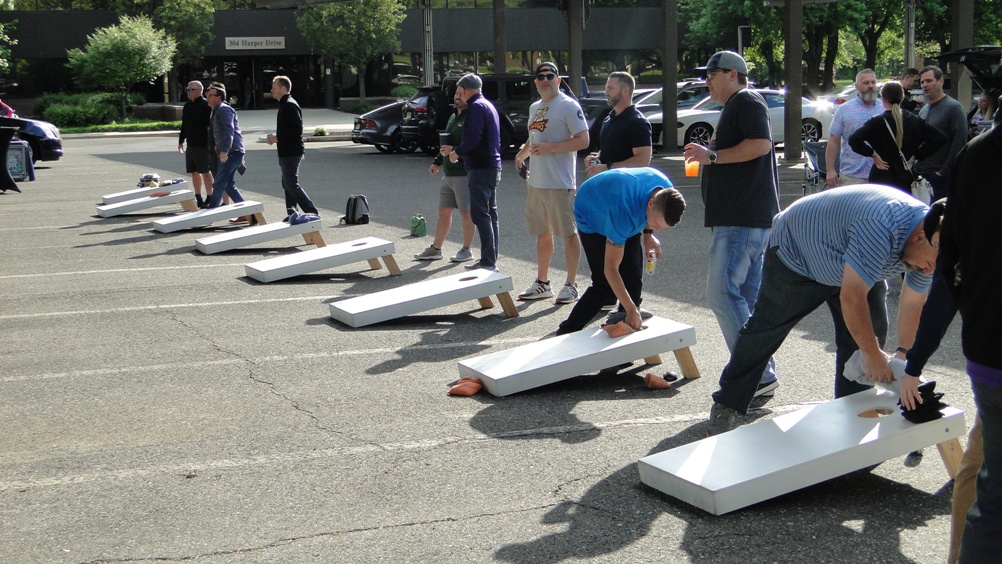
Aspiring cornhole pros at the Legacy Club event.
McCarragher is confident that the growth of professional cornhole will continue, even with the return of other spectator sports.
“Did COVID help give it added exposure? Absolutely. But I will tell you, they have been working behind the scenes with these little ESPN contracts now for several years. They were on ESPN a few times in 2018-2019. We had college national championships on New Year’s Eve going into 2020. The ratings were slowly going up and up. So this was already on the rise.
“Just by the sheer TV contracts that are coming in and new sponsors, I for sure would say that the ACL is still growing.”
Kitchin agrees.
“I think the success they had during COVID is going to allow them to continue. Will the viewership be the same? Perhaps not, but I think in this country there’s a niche for these types. Like, would you watch baseball, which is hours long, or you’re clicking through and, ‘Oh, cornhole, this is something I do in my backyard. My buddies and me bust our chops all the time, let me watch this. I think that’s what’s opened it up for those types of things.”
Joe Harsh has already experienced professional cornhole’s impact beyond TV.
“For me it’s not even the size of the events and the cool venues we’ve visited. It’s some of the charity work we’ve done, like for veterans groups. We did an interview with a guy, roadside bomb in Afghanistan. Long story short, he’s a double amputee, and he’s thanking me for everything I do, and it just absolutely blows my mind.
“I would do anything for someone like that because they’ve given so much, and they’re thanking us for what we do and the release that we give them. That’s my favorite thing to take away from all of this.”
Needless to say, McCarragher is eager to keep telling the story.
“I would love that guys would call and have me do a national college football championship. As young broadcasters coming up, we all hope to get that call. But even that being said, I still really would always hope I can continue doing cornhole.
“I will do this for as long as they’ll let me, because I love it.”
Hope you enjoyed this article about Professional Cornhole…
If you did, I would really appreciate your support.
When you use this link to shop on Amazon, you’ll help subsidize this great website…at no extra charge to you.
Thanks very much…come back soon!
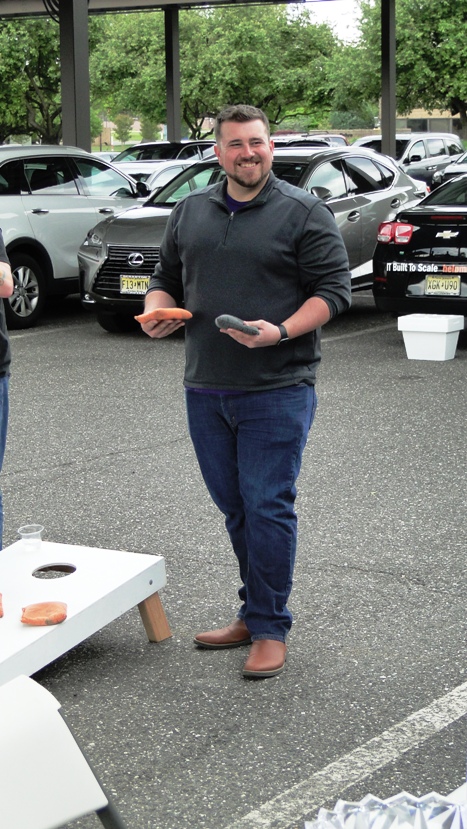
T.J. Smink, defeater of cancer and local cornhole legend.
Smink Strong
T.J. Smink, who won the Infinity Club Cornhole Event with his partner Kyle Reider, had personal reasons for both winning and co-arranging of the event: he is a cancer survivor himself.
Smink is a Senior Account Executive for Premium Seating with the Philadelphia Union. But in 2020, the shutdown of sports was the least of his worries. In December of 2019, he was diagnosed with stage four Hodgkin’s lymphoma.
He decided to control two things that he could control: his hair and his attitude. He shaved off the hair he felt he was going to lose from treatments…but ultimately didn’t. And he kept upbeat, all the time.
“I made sure to keep a positive attitude, to look on the bright side of life. Having that mindset, being able to say I’m going to beat this s***, that was way more than half the battle.”
Legacy Club member Devin DiNofa, at the time campaigning to be the Leukemia & Lymphoma Society’s Man or Woman of The Year, reached out to Smink.
“He’s an awesome dude,” Smink says. “He asked if I would be on his team to help raise money for others. Even then, he wanted to work with LLS to raise funds for me directly, LLS said we can’t go towards one specific person.
“Even then, I went back and told him, I’m killing this s***. We’re good, I appreciate it, but I would prefer it goes to someone who actually needs the funding.”
Today Smink, at DiNofa’s urging, is campaigning for the LLS Man or Woman of The Year himself. The Infinity Club Cornhole event was a part of that, to great success.
“Ash (Ashley Dunek) came up with the idea of working one of the Infinity Club events into a fundraiser. And we had a really big turnout. There were 32 teams and a lot of people that came just to hang out.
“Our team is going to get a research portfolio named after us. I’m excited to see where that research goes.”
And he and Kyle Reider topped it all with a cornhole tournament win.
“He’s a lot better than I am,” Smink says of his teammate, “but together, we normally win all of our friends’ get togethers and stuff.”
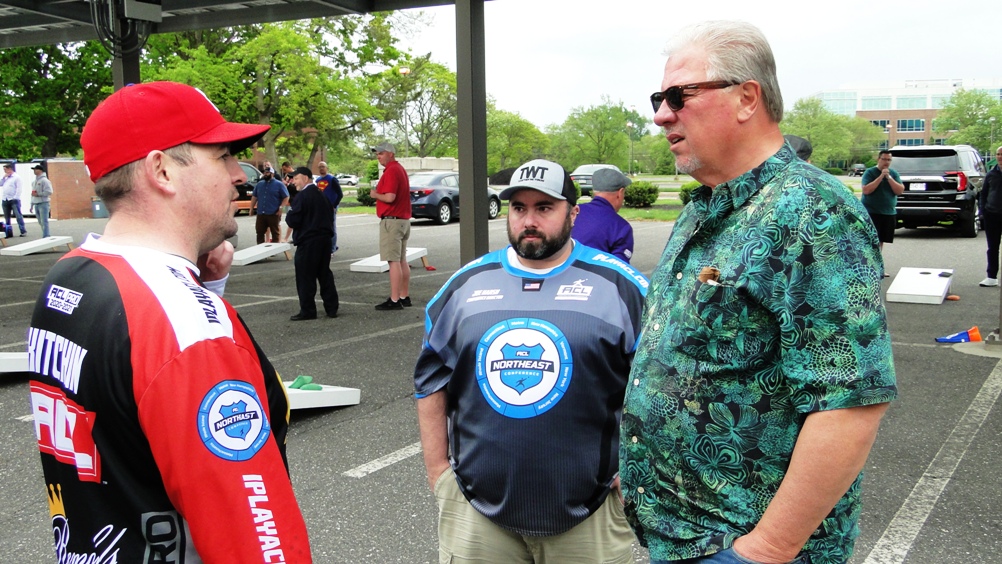
Ken Dunek, feeling relieved at the end of his match with John Kitchin, asks Kitchin for cornhole tips.
So You Want To Be A Professional Cornhole Player?
In a write-up about John Kitchin from Power Equipment Direct’s website, he is described as a professional cornhole player who “practices for roughly 32 hours per week, where he throws 2,000 to 3,000 bags.”
While that is probably technically true, Kitchin doesn’t exactly work in his garage, perfecting his follow through and stance and watching himself on video. He just plays a lot, which to him is the simple secret to improvement.
“When you figure in going to leagues and playing tournaments on the weekends, and then throwing it in my shop or something like that, the amount probably adds up. I play on the leagues on Tuesday nights and Wednesday nights, and Thursday nights usually where I try to get out too.
“If you want to become a better cornhole player,” Kitchin continues, “just get out and play, go find a local league. Even if it doubles as a night out, you know, go out and play. You’ve just got to get throws in, and if you can’t and you just throw in the backyard, go out and throw. You have to throw bags.
“So practice for a pro to me would be going out and playing in your own league and it’s all about getting throws in.”
Wait, no proper ways of holding the bag? No commentary on wrist movement? Nothing about how to warm up? Kitchin says that once you find a groove that works for you, the mental aspect is far more important. And that part can’t always be taught.
“I’m probably the worst pro to talk about this, because I’m a firm believer of under-thinking. People overthink. It’s whatever is most comfortable to you, you just have to tweak that. Throw eight bags, and I would want to see how you threw. And I would say, was that comfortable? If that’s comfortable for you, you can tweak it from there.”
That sounds simplistic, but he’s right. Cornhole players lose matches overthinking.
“I might throw 50 bags in a row in the hole, but what changes from the time that you just threw 50 bags in a row and then you line up next to me? What just changed? Nothing changed except for your mental, so you’re overthinking it. Now all of a sudden that same guy who’s just hit 50 bags in a row off to the side warming up, is now maybe two on two in. It’s the overthinking.”
“I try not to worry about all that.”

Cornhole for a cause.
Why We Cheer – The Human Interest Stories
The ACL is fortunate to have Jeff McCarragher behind the microphone, because he does what the best broadcasters do…he tells backstories about the participants.
He shared a small few everyman stories of cornhole stars with JerseyMan.
“Steven Bernacet, he won the singles national that we just had in Wichita about a month ago. Outstanding cornhole pro, but in his senior year, he was a great high school football player, lineman. He was in a horrific car accident and broke his neck. He could have died.
“The doctors immediately told him he wouldn’t play contact sports ever again, obviously to a high school kid who’s played sports his whole life, it’s devastating to him and his family. Two years later, once he was able to rehab and get back to his new normal of life, he picked up cornhole, and has been playing cornhole ever since now.
“It’s been his outlet and his happiness and his source of competitiveness, to fill that desire and that need in his life. Cornhole has been literally life changing for him.
“One of the top female pros is a manager at a Taco Bell. You know, she plays cornhole on the side. Daymon Dennis, who’s the number one player in the world right now, worked at a cheese plant for 27 years.
“He used it to support his family and to keep food on the table. And now here he is, number one player in the world.”
“It’s like American Idol,” McCarragher says. “There’s a lot of people who can sing, but what captured the audience and the ratings for American Idol is all the backstories.”

Wheelchair Basketball – Rolling Thunder

I had never known that wheelchair basketball was as established as it was, with professional leagues and established teams, until JerseyMan asked me to cover it for their December 2014 issue. I had the pleasure of interviewing John DeAngelo, a player for the Magee Spokesmen of Philly, who filled me in on the rough and tumble nature of the sport. You can view the PDF from the article here.

Rolling Thunder
Think wheelchair basketball is a small time, friendly competition? Think again.
At the Carousel House in Fairmount Park, the Magee Spokesmen are wheeling laps around the basketball court at the start of their weekly practice session.
After a few dozen circuits, they gather at one end. They begin start and stop drills, rolling out to the center of the court, stopping on a dime, executing hard 180-degree turns, and pushing back in the direction of the net.
Their coach, Eric Kreeb—who by day is a kitchen manager at Chickie’s and Pete’s—stands by and watches, smiling and shouting words of encouragement. Slide right, he shouts, turn and get on the line. The drills continue. Men push, turn, and then go from one end to the court to the other and then back…backwards. They pant, strain and sweat.
Back at the line, they’re huffing a bit now. “Turning left this time,” shouts Kreeb. His direction is met with some mild groans of protest. But the Spokesmen oblige, rolling out, turning left and rolling back. To some, it’s a competition. “Get your money!” one player shouts repeatedly. Forward and backward, turning wheelchairs left and right, drill after drill after drill. The practice is almost an hour old, and no one has yet touched a basketball.
Finally, they start shooting, taking turns at the foul line. As they shoot, two players practice defending one another, maneuvering a specially designed chair with an ability that clearly isn’t learned overnight.
The team splits into two groups and gather at either end of the court. A scrimmage game begins. Wheelchairs clang into each other as players jockey for a position. Fast breaks happen, as do lay-ups, fadeaway baskets and rebounds. Players even occasionally fall out of their wheelchairs, but such incidents only briefly delay the action, and they are back up quickly.
One can only imagine the toll a whole game of this—or six whole games of this—would take on someone who isn’t built up for the battle.
“We prepare for our games at practice,” says Kreeb. “We do several stamina building drills, diagram plays, go over defense, and discuss strategies of attack against our upcoming opponents. The conditioning is particularly important because we play in tournaments. Most tournaments you play five to six games in two days.”
This is no playful, recreational diversion. It’s a real, honest team practice. It is the grueling, repetitive effort that athletes put in that makes their feats on game day look effortless. The Magee Spokesmen are professional athletes. It’s obvious by the way they miraculously avoid collisions and effortlessly land passes into teammates’ hands.
The focus of wheelchair basketball isn’t the wheelchair. It’s the basketball.

John DeAngelo, professional wheelchair basketball player.
The words “wheelchair basketball” to most people probably bring to mind images of a few guys sitting around shooting baskets in an ultra-friendly lightweight competition. The idea of it being an international sport, with leagues, divisions, and tournaments, would likely come as a surprise.
The sport began in veterans’ hospitals shortly after World War II, as paralyzed war heroes adjusted to their new life. As the sport grew and teams emerged across the country, the National Wheelchair Basketball Association was formed. Today the NWBA has over 200 teams in 22 conferences, many of them sponsored by local NBA teams.
Internationally, since the formation of the International Wheelchair Basketball Federation (IWBF), the sport has even more notoriety, particularly in places like France, Australia and Canada. Australia is the current IWBF men’s champion; Canada’s team took the women’s wheelchair basketball title this year.
John DeAngelo, a player for the Spokesmen, took the time to educate me a bit about the sport. Born with a congenital affliction, he has been playing wheelchair basketball since the age of 12.
“The first thing, leaving basketball aside, is just getting used to a wheelchair,” he says. “It sounds easy, but maneuvering a wheelchair is not as easy as you might think. Before you learn anything else about ice hockey, if you can’t skate, you can’t do anything. The players who really excel, it’s like the chair is almost an extension of their body.
“Then you start to throw in the sport part, dribbling a basketball and learning how to shoot and maneuver around people that are trying to defend you. The mechanics are the same way; you just take the legs out of it. The upper body mechanics are the same. There are rule differences in wheelchair basketball that change things a little bit, but you still have to dribble.
“The thing that you start to notice, and that’s what everyone has to learn in practice, is that instead of just a body banging around, you’ll hear a little more metal crashing into each other. That’s when you know someone’s comfortable with it, whereas there are guys that are very apprehensive about smashing into something.
“They’re the rookies!” DeAngelo says with a laugh.
The NWBA, NBA and NCAA are more similar than they are different.
The rules are the same as in the NBA; court dimensions and basket height are the same. There are some rule differences; traveling in wheelchair basketball consists of touching one’s wheels twice after dribbling the ball. There is no double dribble rule, as DeAngelo notes: “That allows you more maneuverability, so you’re not constantly dribbling, or else you really wouldn’t go. Some people can do that really well, but this allows you to maneuver faster and keep the pace going.”
Another difference is that with the nature of wheelchair basketball being such that teams can’t trade players or acquire free agents…players generally play for the team where they live…the best teams become the teams that retain the same players long enough to gel.
“In any team sport,” DeAngelo says, “the longer you keep a nucleus together, the better that team is going to wind up being. We’ve played against teams constantly who’ve grown; a lot of the players were not that good and all of a sudden they start to gel and get better. Year after year you see them grow and they become a powerhouse. North Carolina had always been a good team, and last year was finally their year where they just clicked.”
The NWBA has seven divisions, ranked by the level of competition. The Magee Spokesmen play in Division III, where DeAngelo says most teams are. Division II, he says, is an entirely different animal.
“You have teams out there who are competitive, you have teams with players that are just out there playing, and that’s great. They love to play, they know they’re not that good but they’ll travel to a couple of tournaments and just play. It’s not all about trying to win a championship to them.
“The more competitive you get, yeah, it gets dangerous,” he says.
Yes, DeAngelo has sustained some injuries in his career. In that regard as well, wheelchair basketball is no different from NBA basketball.
“I was playing this past weekend down in Virginia Beach, going for a rebound, another guy’s coming from the other team and wham! We just smashed into each other. I took the brunt of it, I’m not the biggest guy, and I just tumbled to the ground.
“It sounds bad, sometimes it’s bad, but it’s just part of the sport. You’ve got metal on metal, you get run over sometimes, fingers get jammed in wheels, things like that absolutely happen. I’ve had broken fingers, broken arm, several concussions, it’s pretty brutal.”
Today there are over 100,000 wheelchair basketball players worldwide. Most, like DeAngelo, play in organized leagues with tournaments and championships. Some play for national and international titles, which DeAngelo has also done. And the growth of the sport has created a competitive outlet for those at every level who see themselves not as disabled, but as athletes who do things differently.
DeAngelo has represented Team USA, but he’s also happy to have been part of a growing competitive sport.
“Putting on a USA jersey and playing overseas was probably the biggest thing. I did get a chance to play in two national championships for Temple. But for me, the thing I’m most proud about is that there are more programs now for younger kids, so when they’re starting out there’s something structured.
“I was 12 playing with 30-something year-old guys. I had to learn a lot of stuff really quick. Now there’s so much out there, and basketball was a stepping stone for a lot of other things. There are so many sports now for wheelchair athletes that it’s mind boggling.
“It’s a great thing to keep in shape. You slow down a bit like with anything, but the one good thing is that you can be a competitive player no matter what your age is, as long as your body can take it.”
And wheelchair basketball players will get run over, fall out of their chairs, get their fingers jammed in wheels and endure broken arms and concussions, and get back in the game for as long as their bodies can take it.
It’s what athletes do.
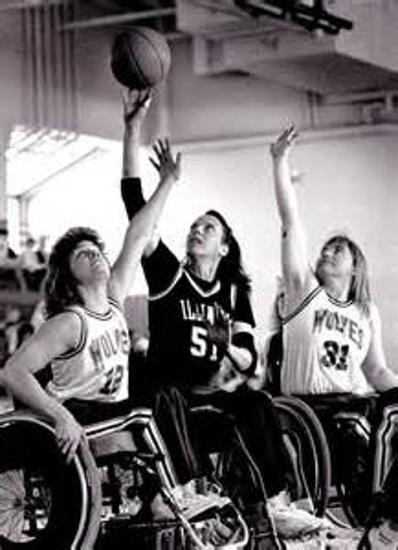
Sharon Hedrick (center), a 1994 inductee in the NWBA Hall of Fame. (photo courtesy of the NWBA)
The Best of The Best – Wheelchair Basketball Hall of Fame
There is a Wheelchair Basketball Hall of Fame, founded in 1973. The NWBA website lists the members and the rules of eligibility—players must compete for a minimum of five years, be a part of an All-American team, and meet other requirements as determined by the voting committee. Non-competitors must give at least 12 years to the sport, as a coach, administrator or supporter.
Among the noteworthy members:
Tim Nugent – Inducted in the inaugural year of the Hall. Nugent was the coach of the first college wheelchair basketball team, the Illinois Gizz Kids, for 12 years. The team won the NWBA championship in 1953. But more importantly, Nugent founded the NWBA and served as its commissioner for 24 years. Today the NWBA has an endowment fund in Nugent’s name.
William Johnson – Also inducted in 1973, Johnson is listed as being the “Best to ever play the game” on the NWBA website. He played for a Long Beach Flying Wheels team that won five straight championships, and he also played for three U.S. Paralympic teams. Johnson later served as the commissioner for the Southern California conference of the NWBA.
Dan DeDeo – Inducted in 1976. DeDeo was one of the first ever certified officials of the NWBA; he officiated in the Eastern Conference (EWBC) for 14 years and later became the EWBC Officials Chairman and the Pacific Coast Commissioner.
Sharon Hedrick – Inducted in 1994, Hedrick was the first woman to be inducted into the NWBA Hall. Hedrick played for the University of Illinois team, winning six MVP awards and seven team championships. She later won medals playing for three U.S. Paralympics teams…the one year she sat out, the U.S. failed to bring a medal home.
Strapping In…
Wheelchair basketball players generally don’t use their own wheelchairs; they play in specialized wheelchairs designed for sports. The sports chairs are made of titanium, don’t fold, and have their wheels angled for more camber and easier mobility.
DeAngelo describes the differences. “Typically, the standard chair, a lot of them are made with titanium, so they’re lightweight, durable. Back in the day when we were first playing there were these old-fashioned spokes that you’d see on a bicycle.
“The biggest difference in the chairs is that less is more. Some people would ride them around in the streets, but you wouldn’t necessarily see that. For my wheelchair, I have these bicycle tires on there for everyday use. For the basketball court they are very thin ones and they would get torn up on the streets.”
They have safety features as well, like the additional small wheels in the rear. “When I first was coming up the biggest thing was that your chair would flip backwards. Someone would hit you in the back of the tire with their foot pedals and your chair would flip right over.
“Now the chairs are made with what we call a fifth wheel or sometimes six wheels on the back of the frame, it’s kind of like training wheels. You still might flip backwards, but it’s not going to be as quick or as pronounced as it would have been.”
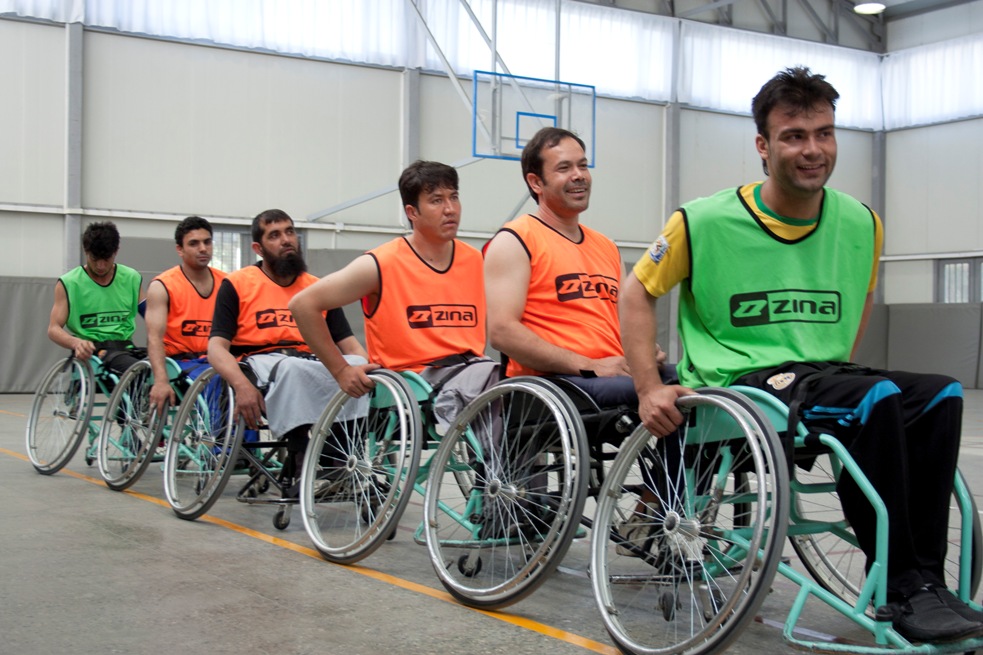
Shapoor Sorkhabi from Maimana (right), the Man of The Match in Afghanistan.
(photo © ICRC / Jessica Barry)
The Thrill of Wheelchair Basketball Victory
Wheelchair basketball has grown quickly in the war torn country of Afghanistan, where a great many civilians have lost limbs to mines and ordnance that are literally everywhere. Recently the International Committee of the Red Cross and U.S. basketball player and trainer Jess Markt began organizing sports programs to help amputees.
The response has been overwhelming…there are hundreds of men and women playing wheelchair basketball now in an organized league.
In June of 2012, after just two years of the program, the ICRC held its first national tournament. It featured teams from four Afghan cities: Mazar-I Sharif, Kabul, Herat, and Maimana. Thanks to the “man of the match”, then eighteen-year-old Shapoor Sorkhabi, the Maimana team triumphed over Herat in the final, 14-4.
After playing for only four years, Afghanistan now has a national team that competed for the first time internationally in May. The ICRC website features profiles of some of the players that competed in Italy, talking about the difference wheelchair basketball has made in their lives.
Says Sorkhabi, “My mother tried to discourage my love of basketball, saying I should put my studies first. But I persisted and started playing four years ago at the physical rehabilitation centre in Maimana.
“I played in a wheelchair basketball tournament and was made ‘man of the match’. After that my mother became proud of me. I was proud of myself, too.”

